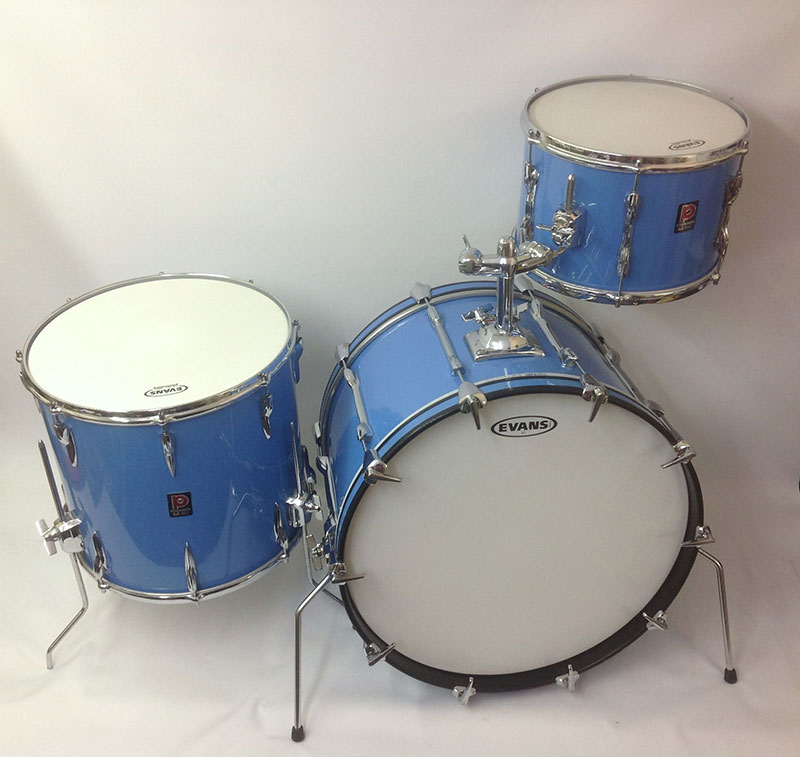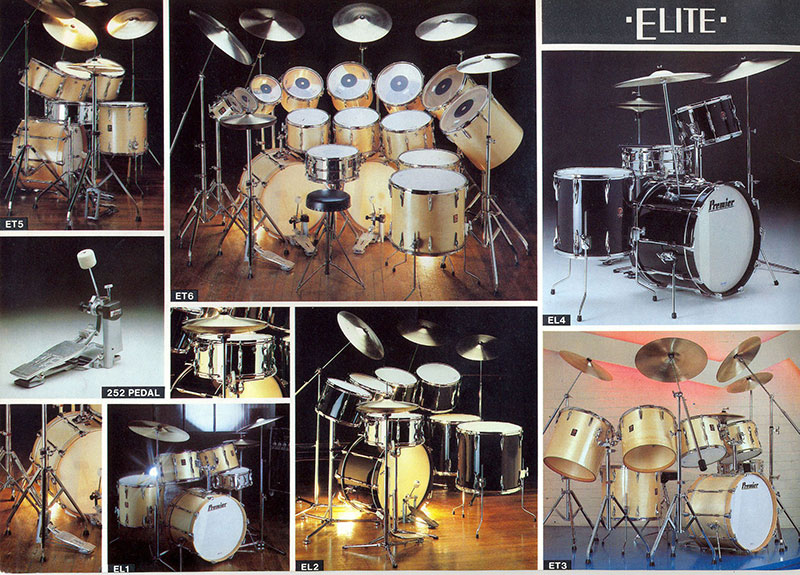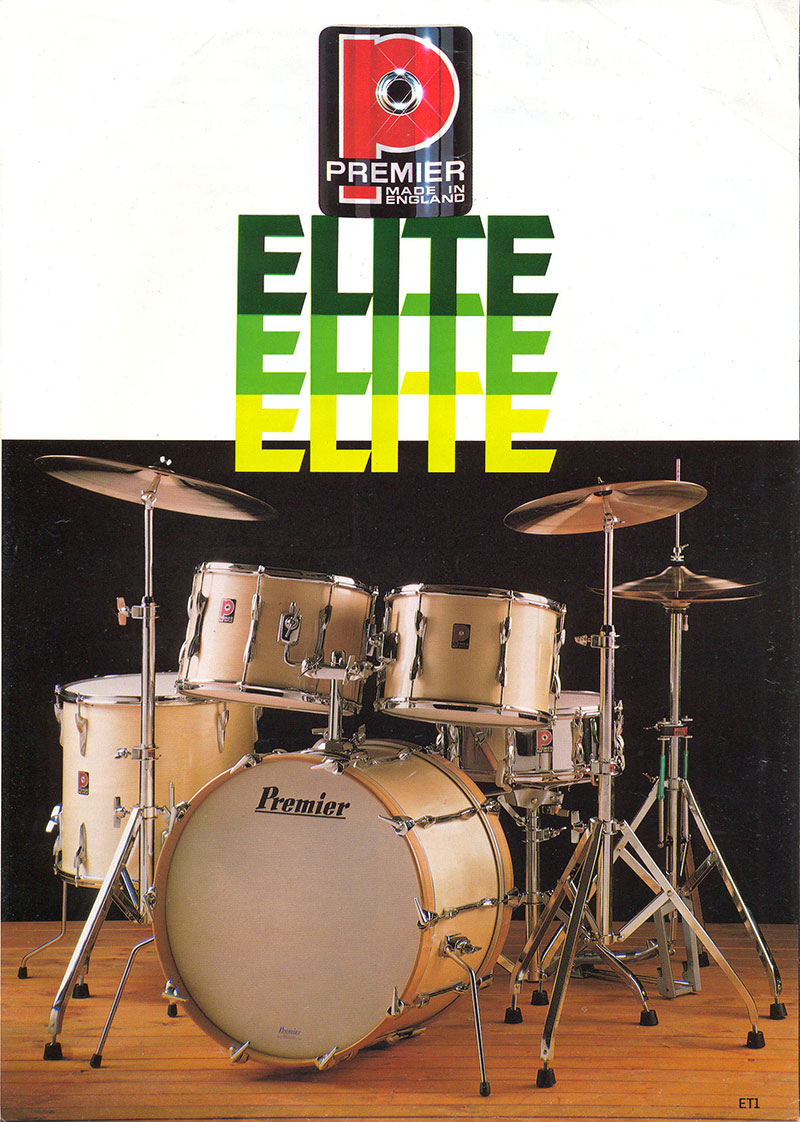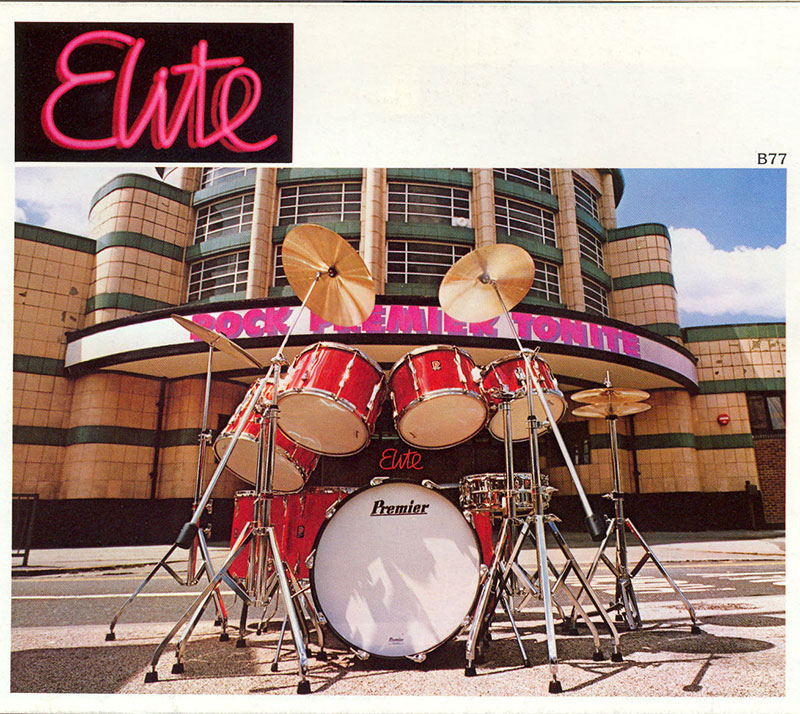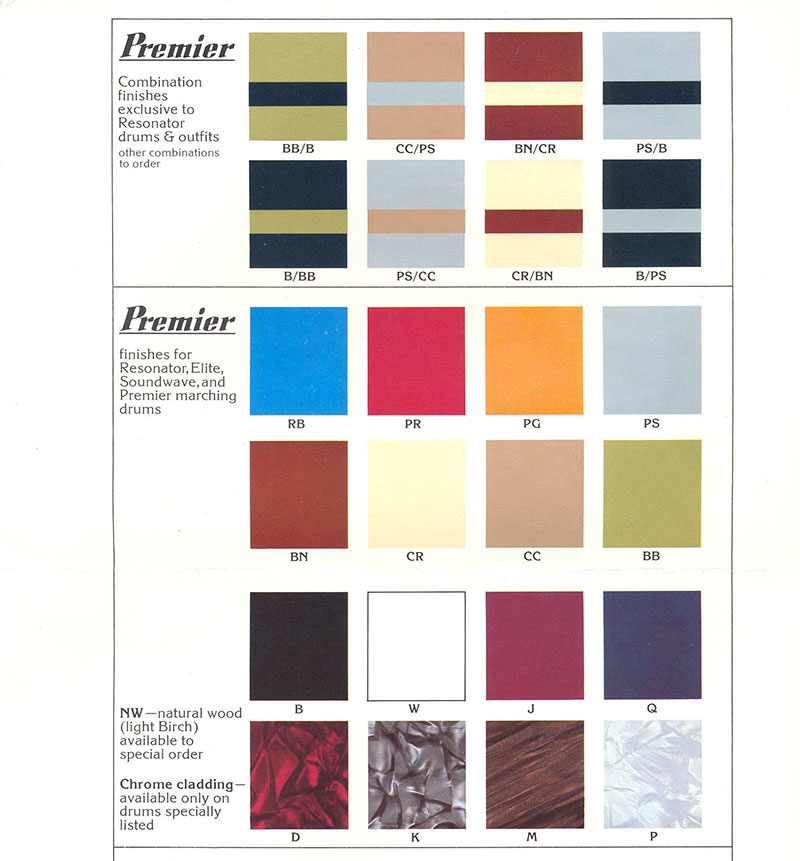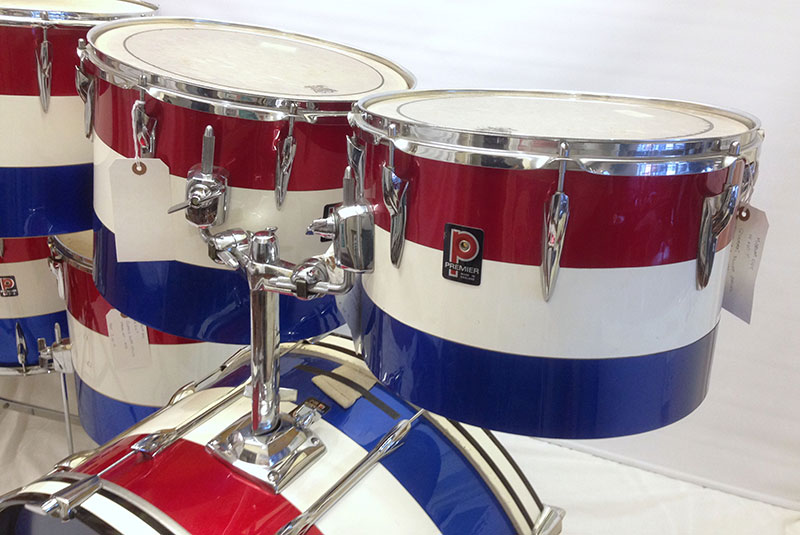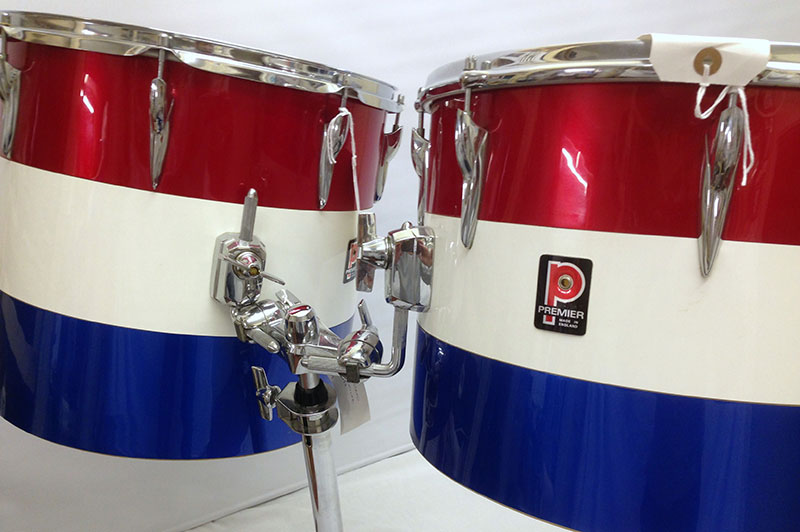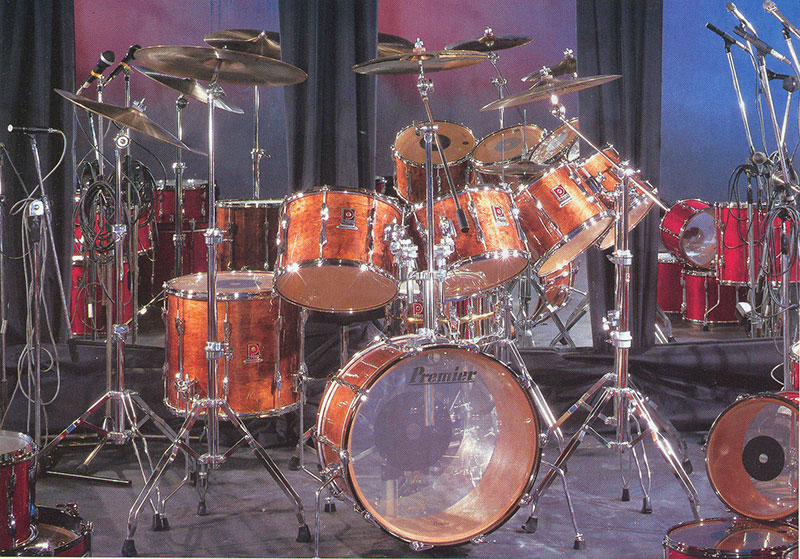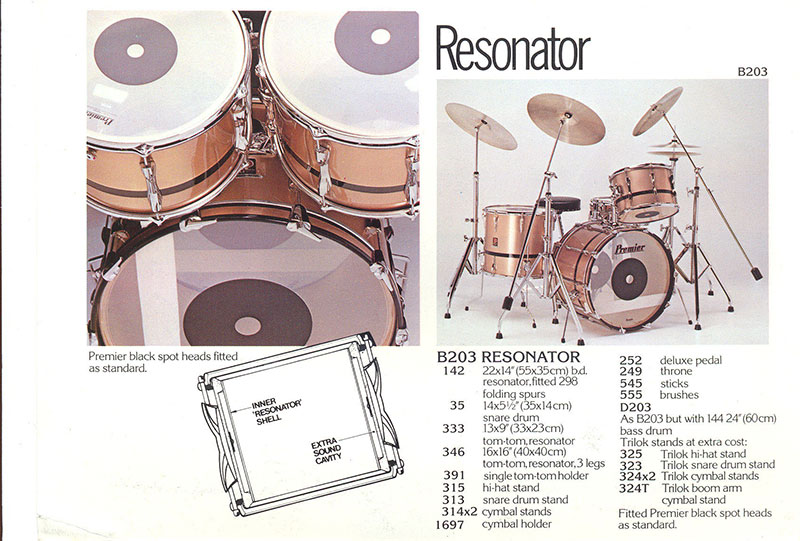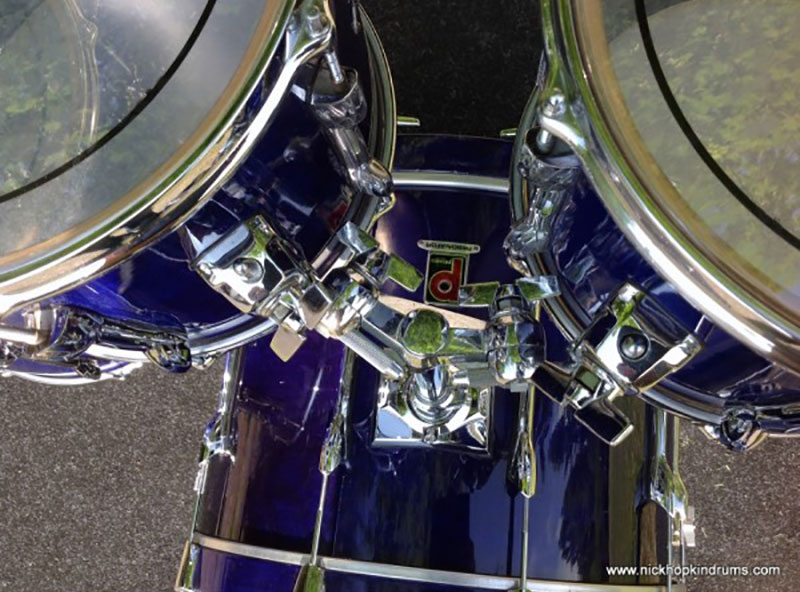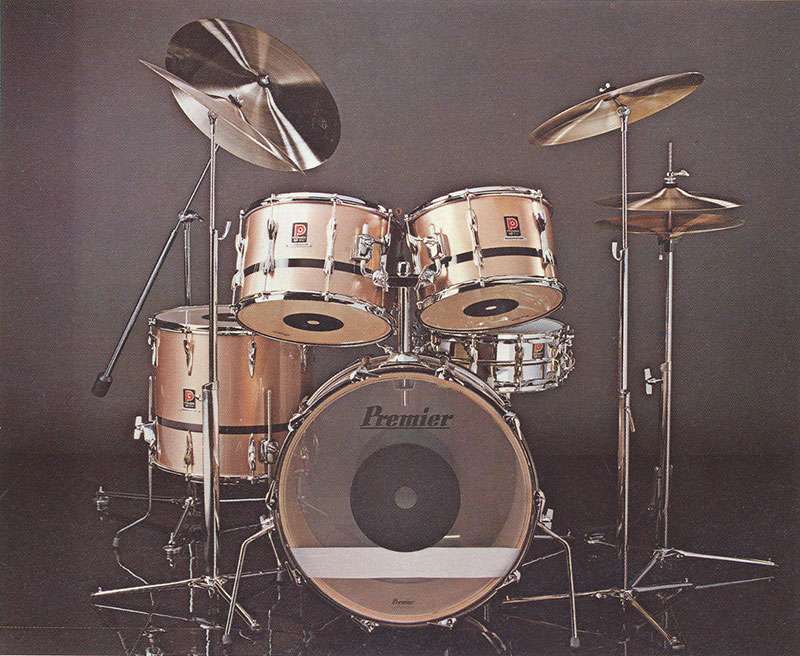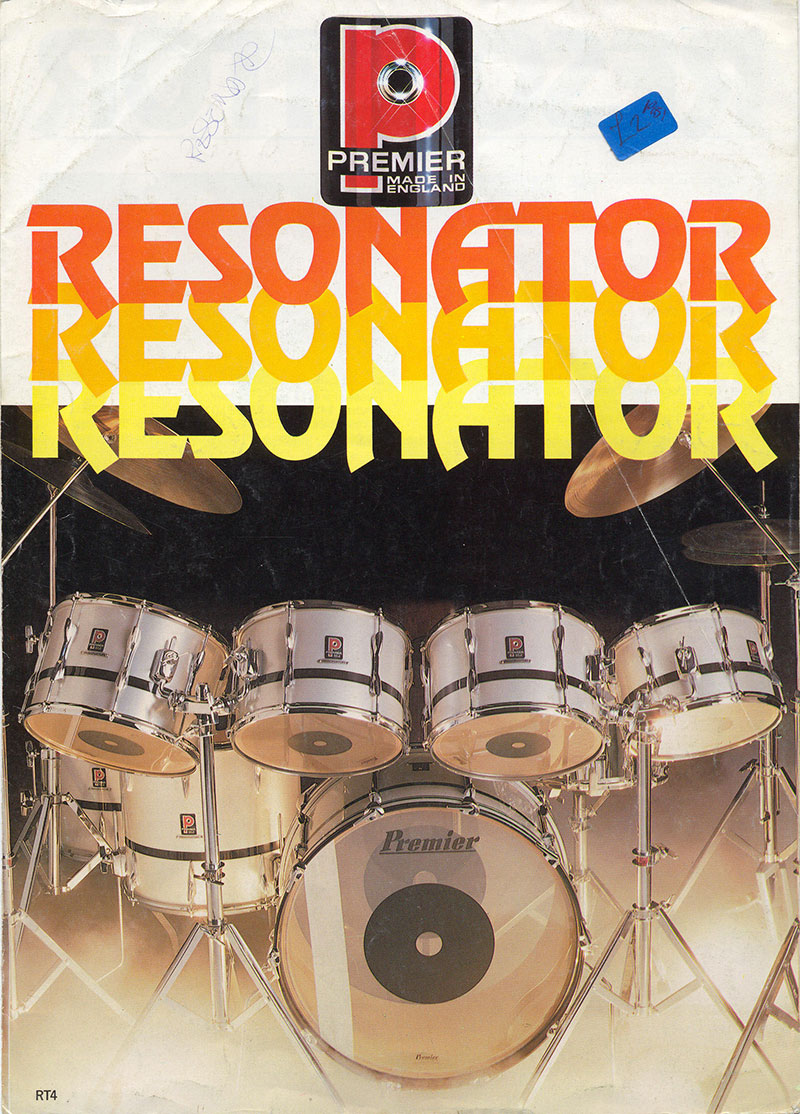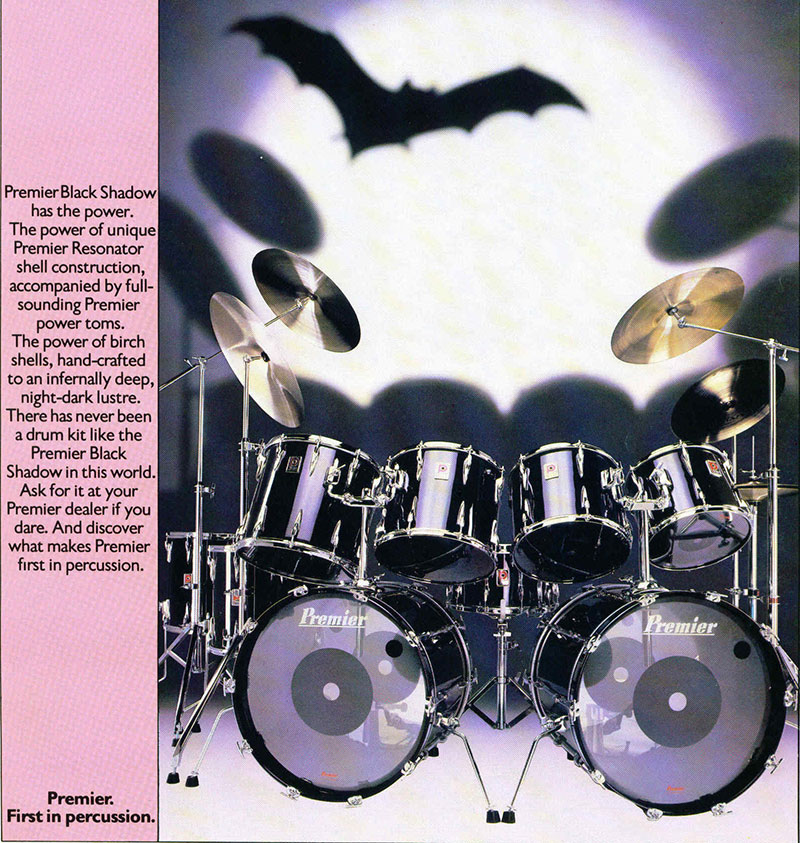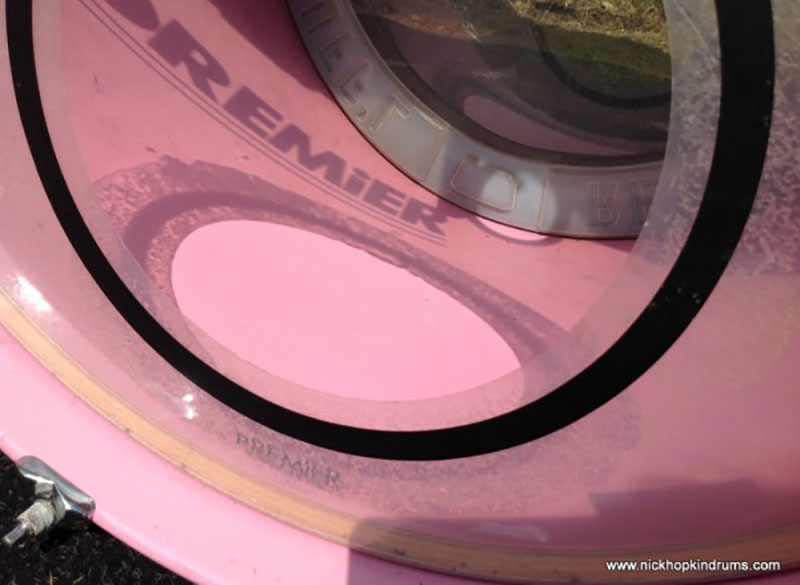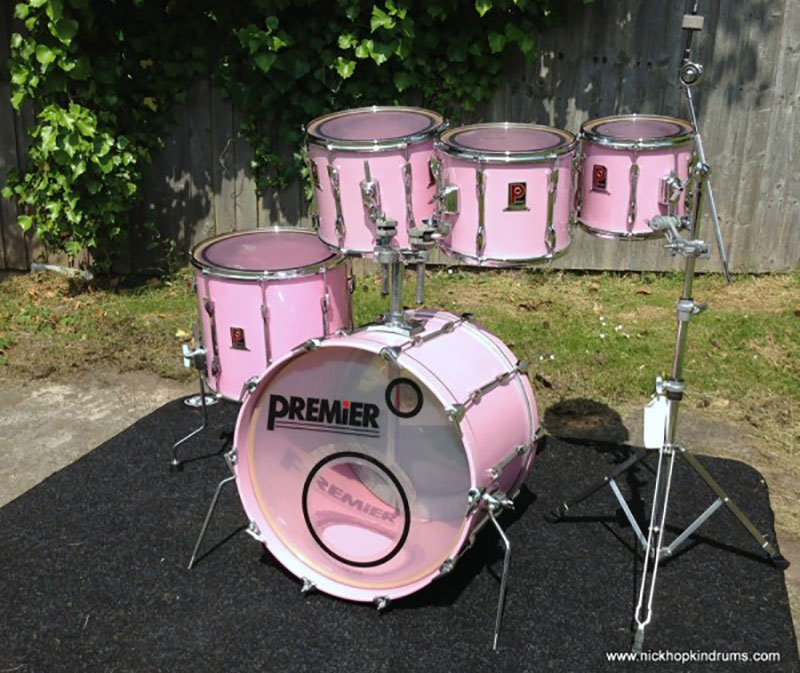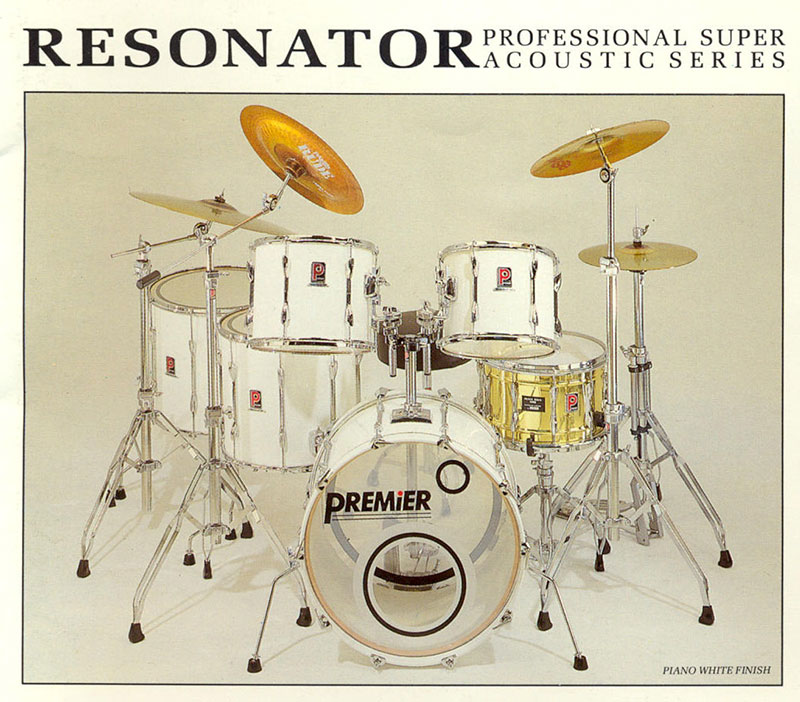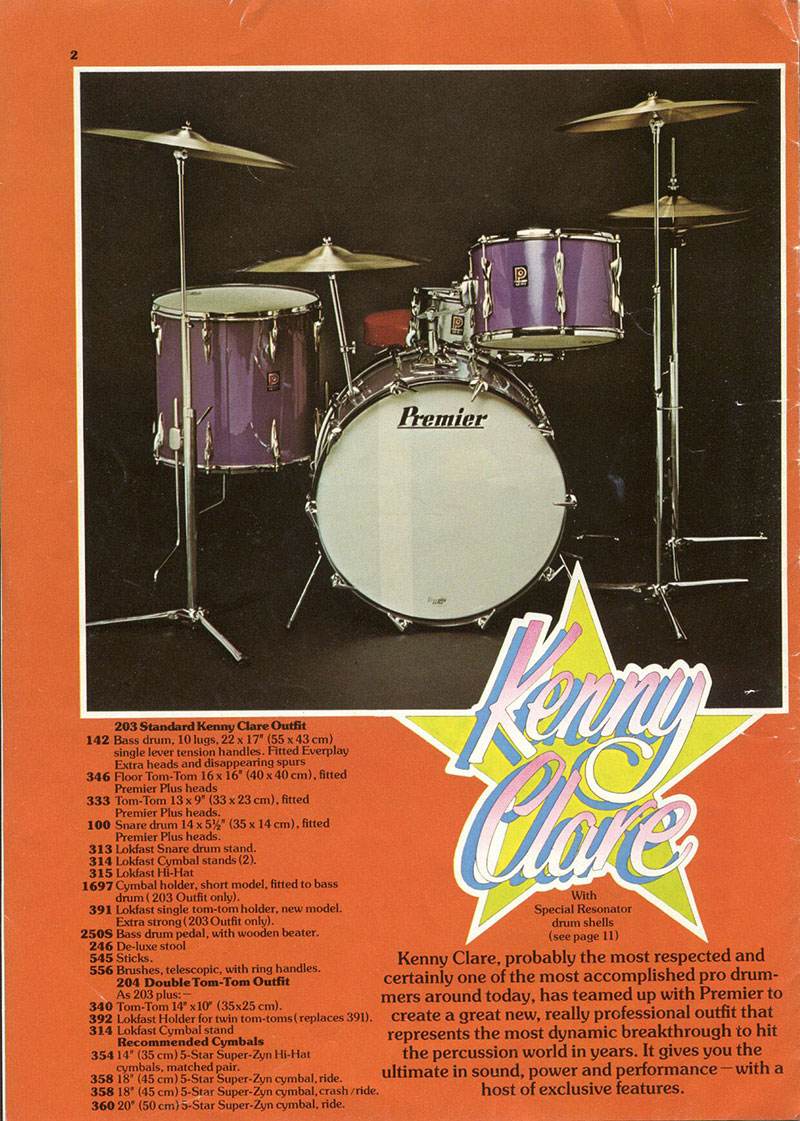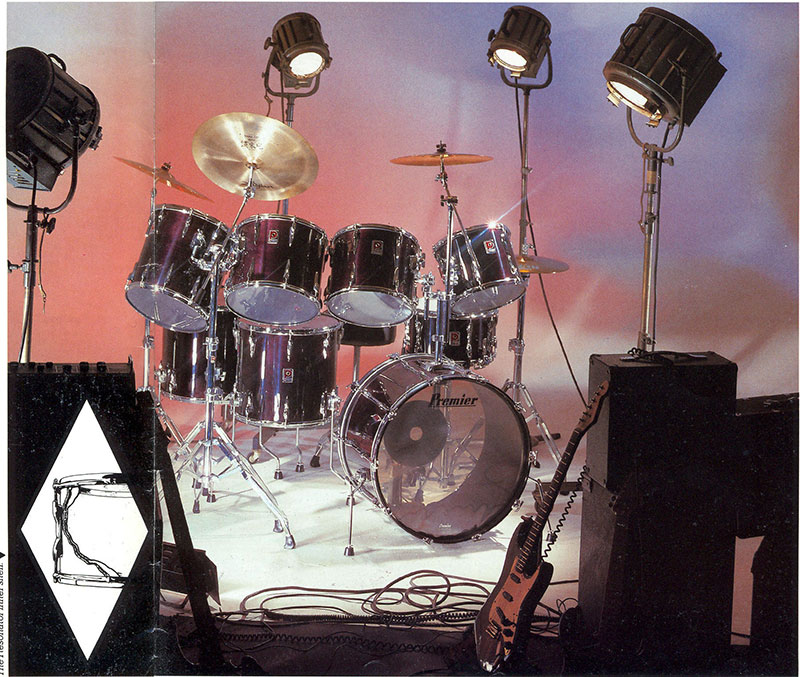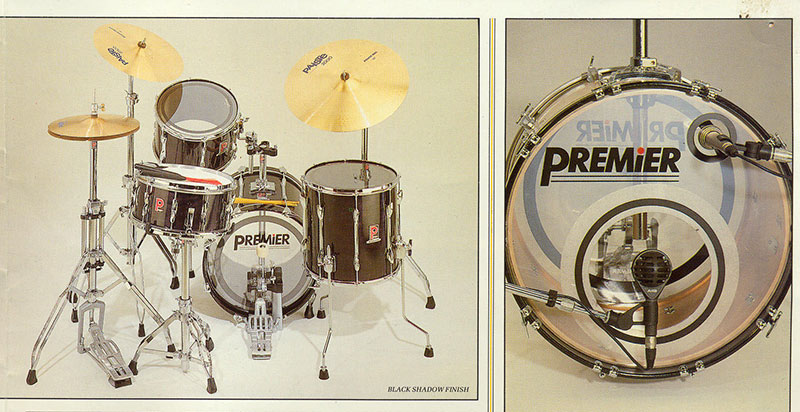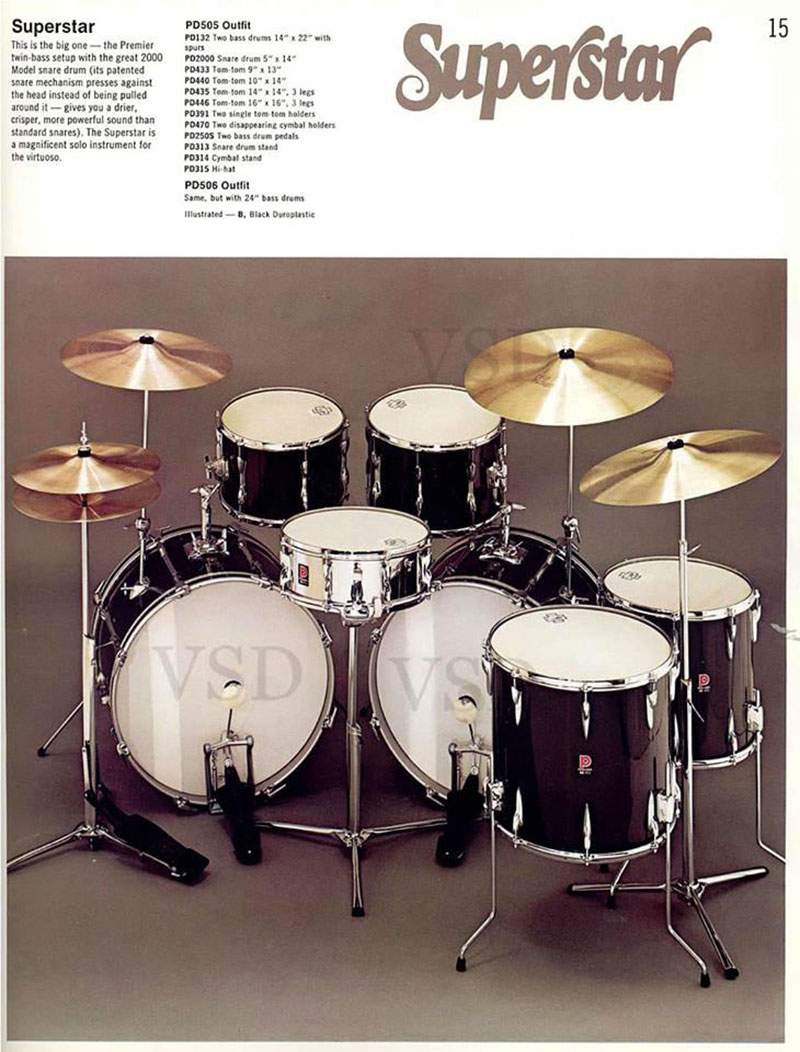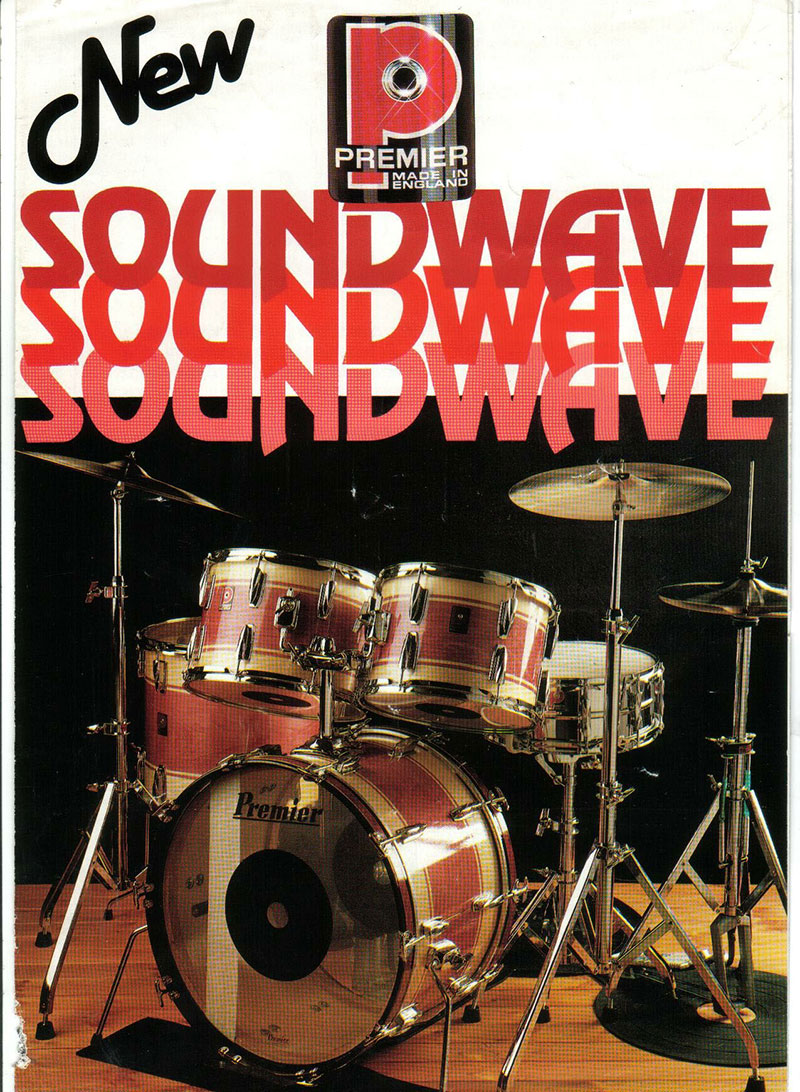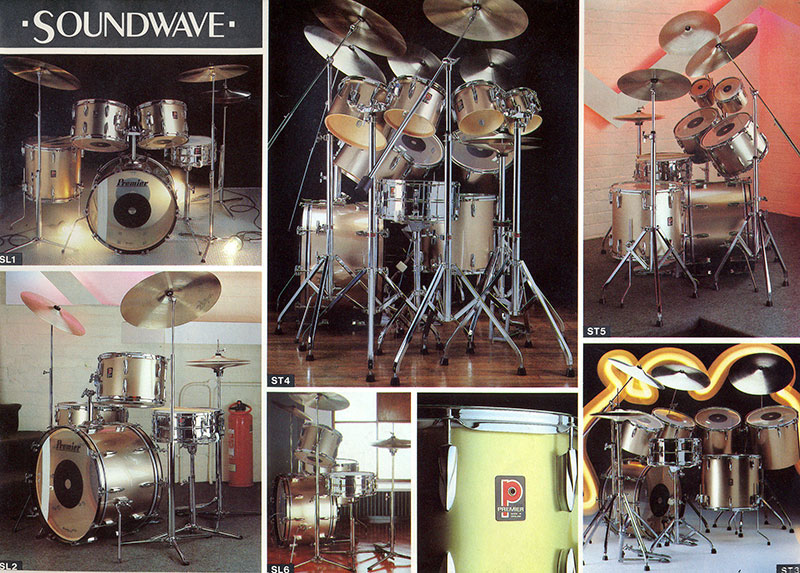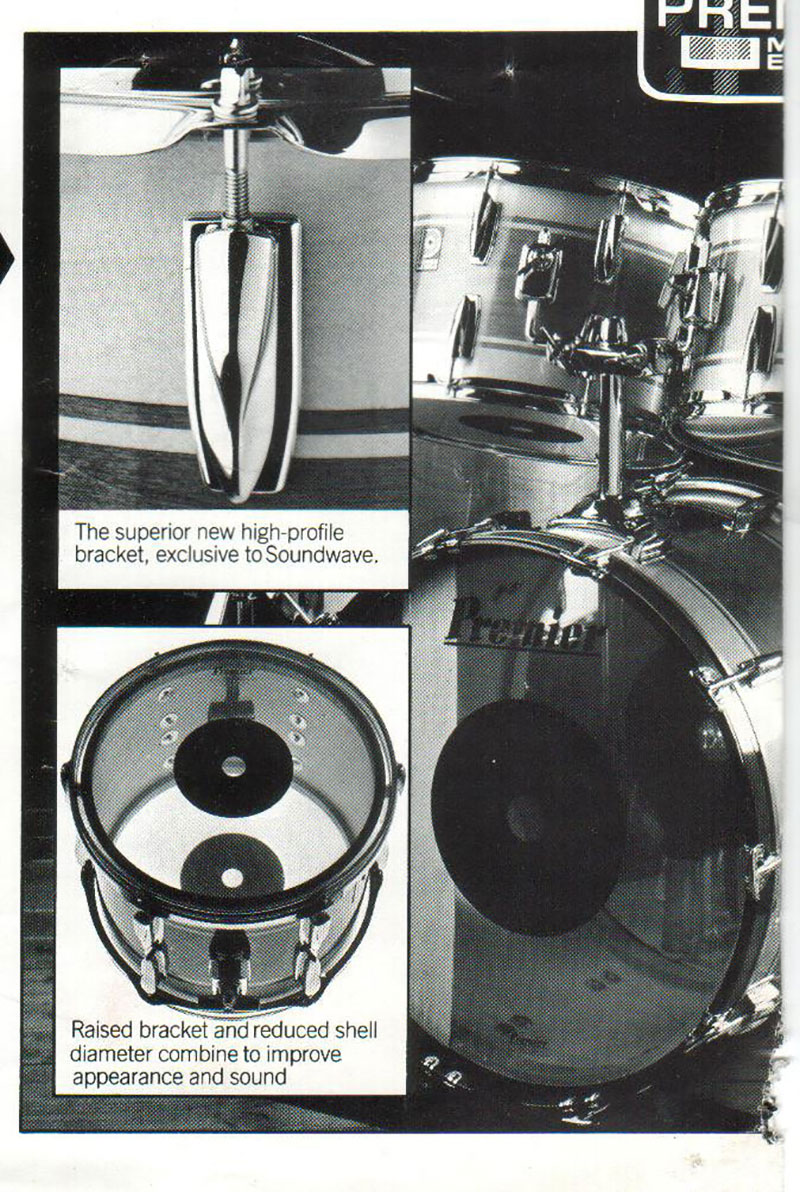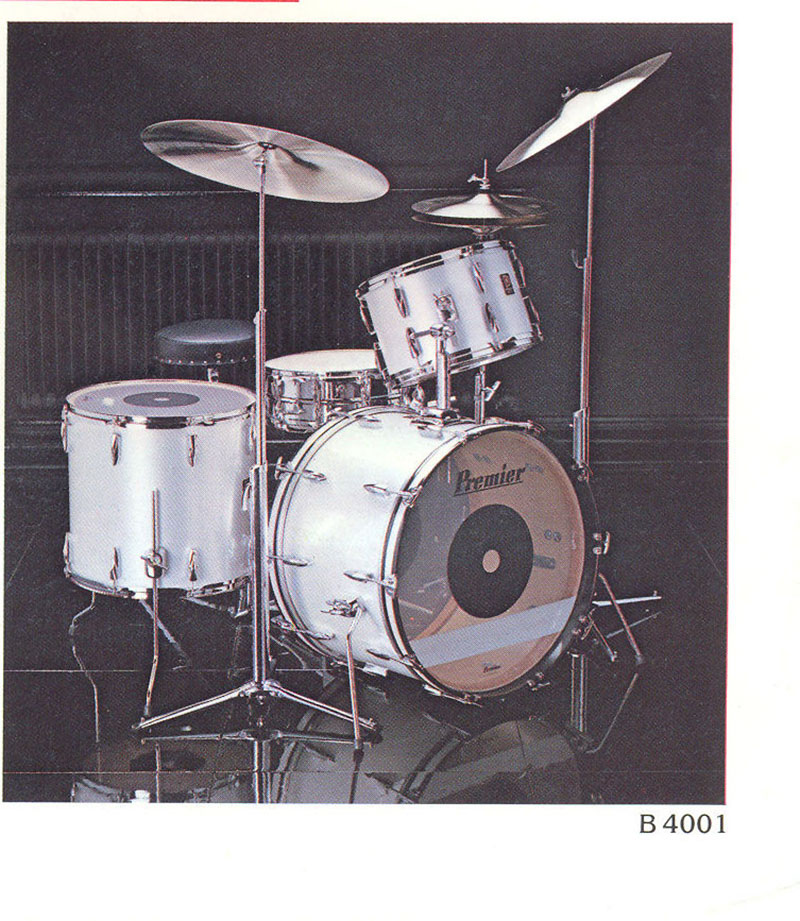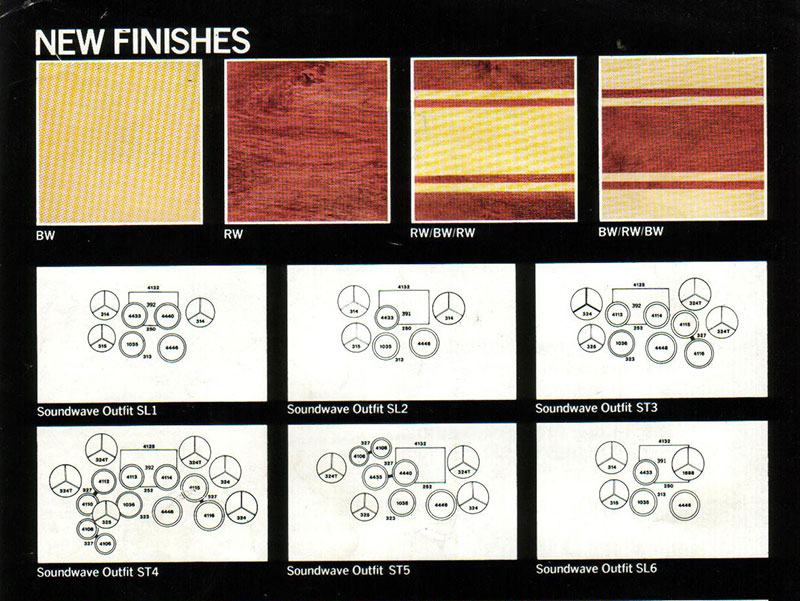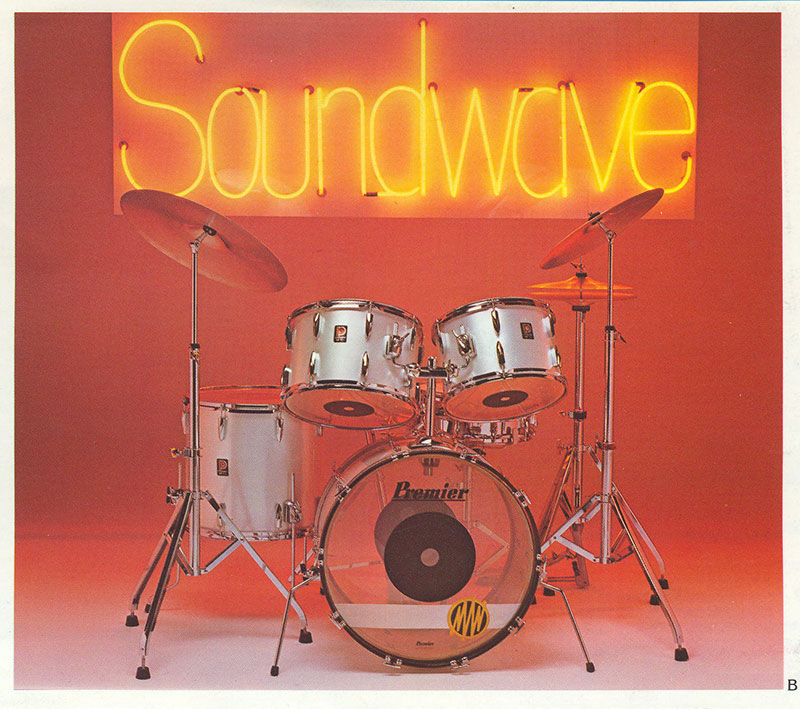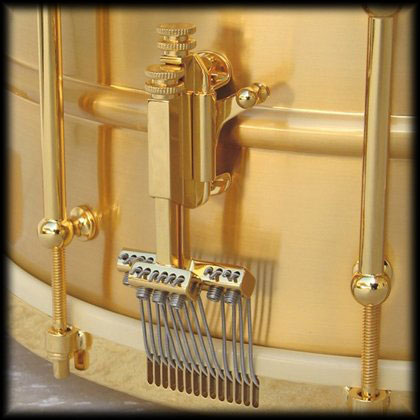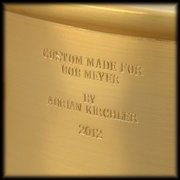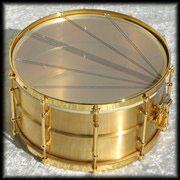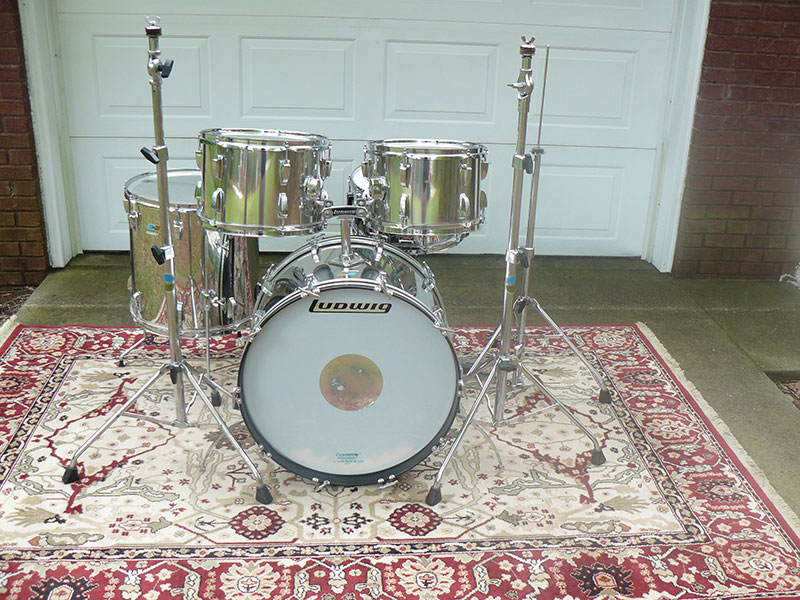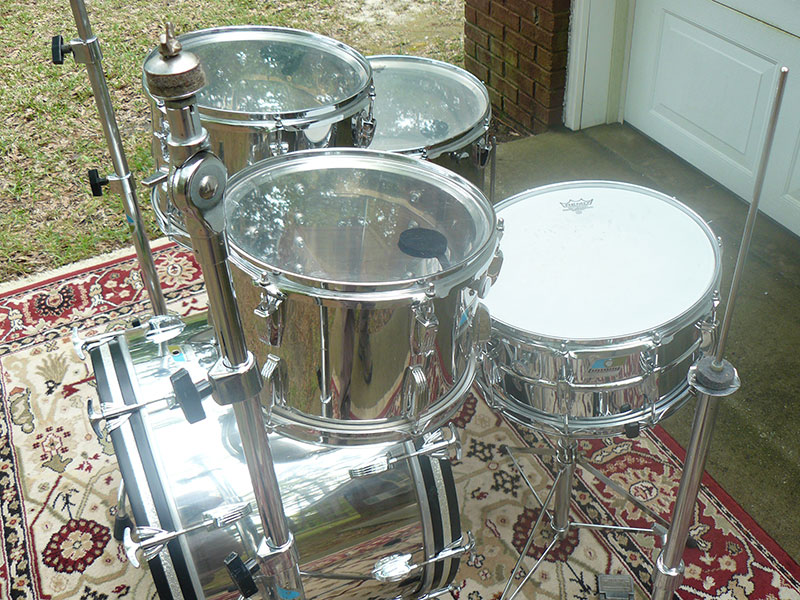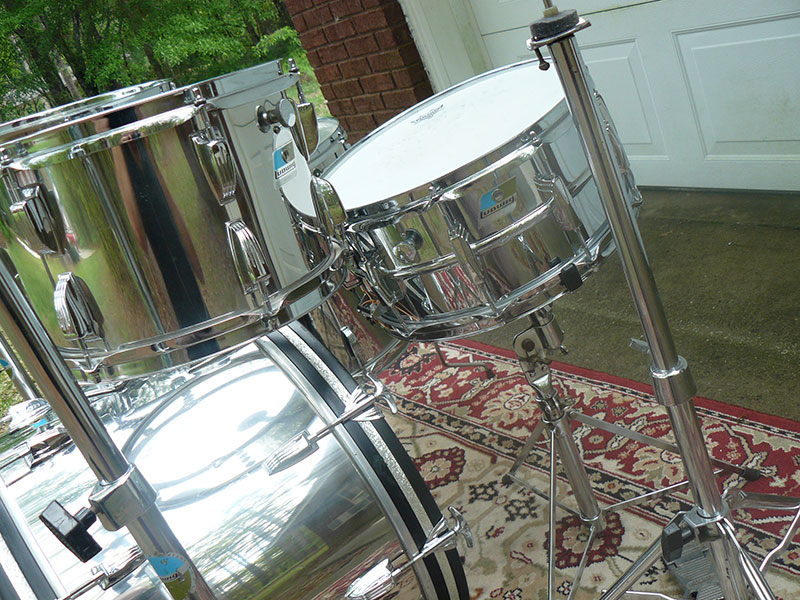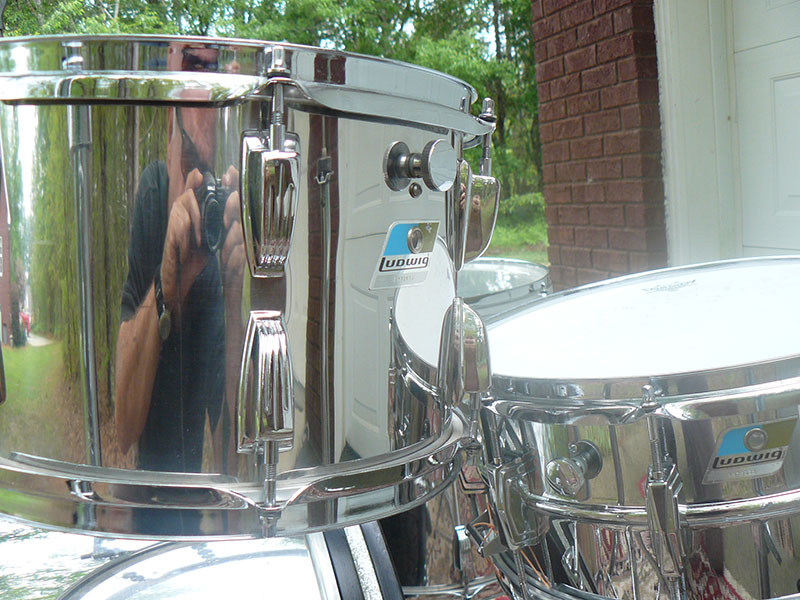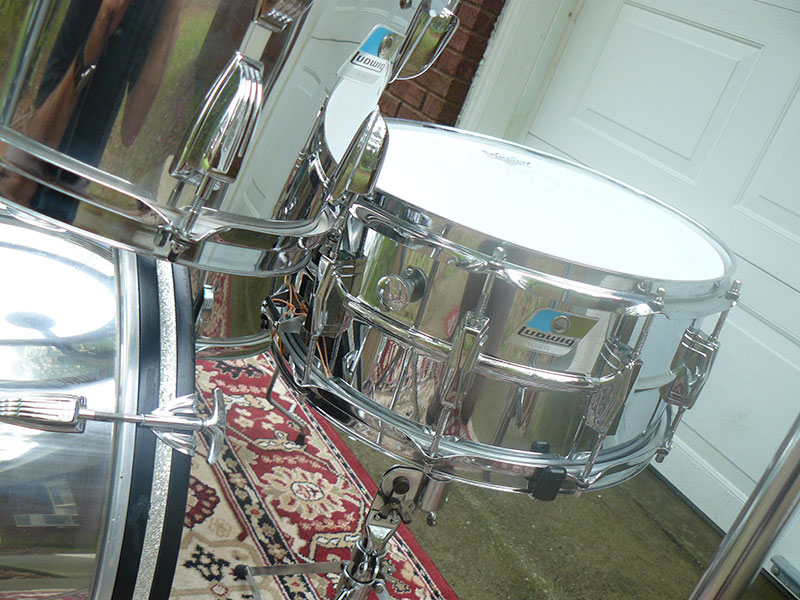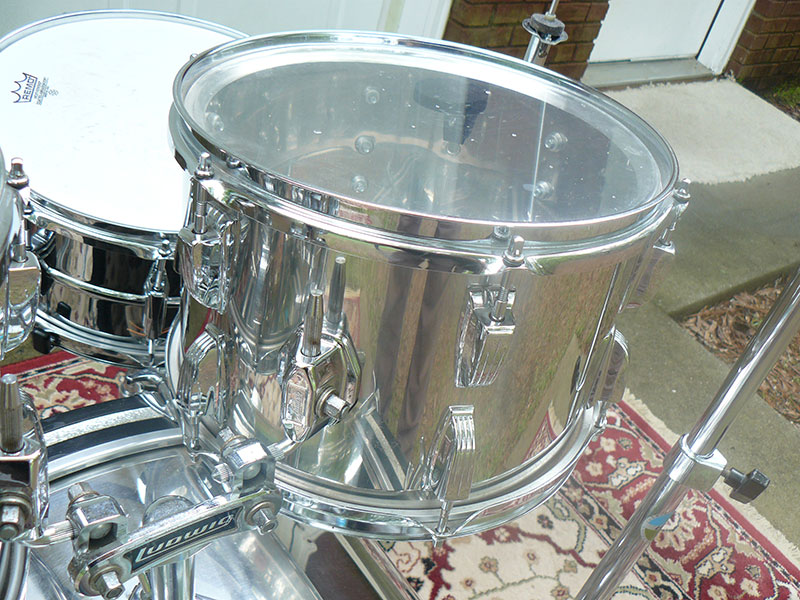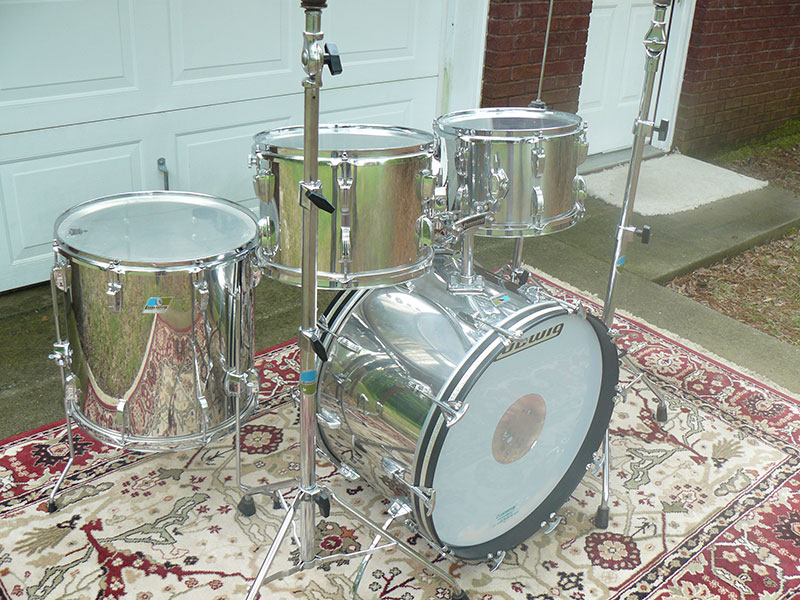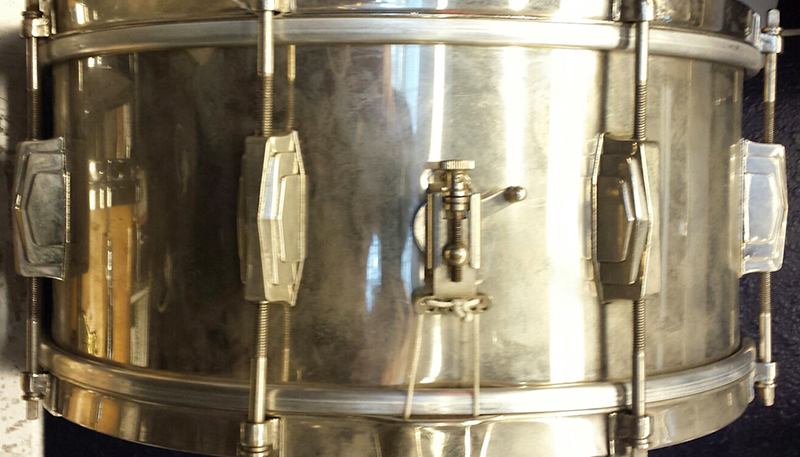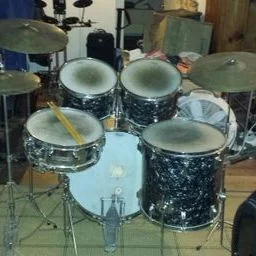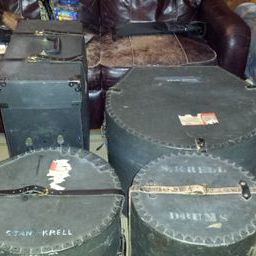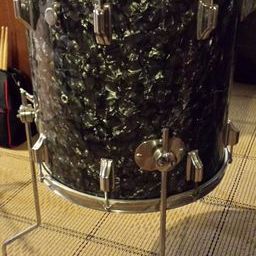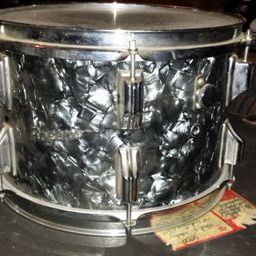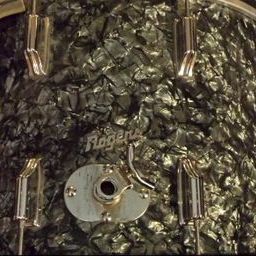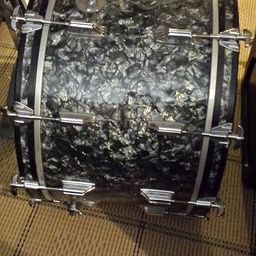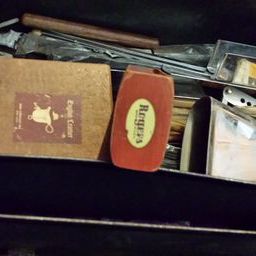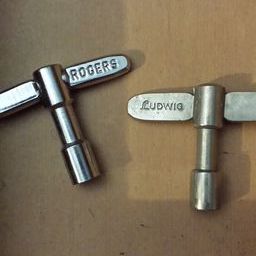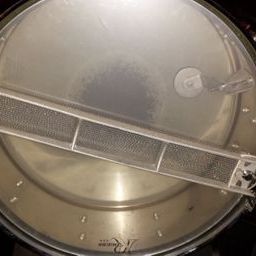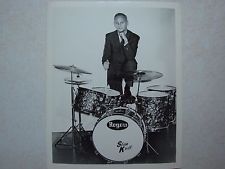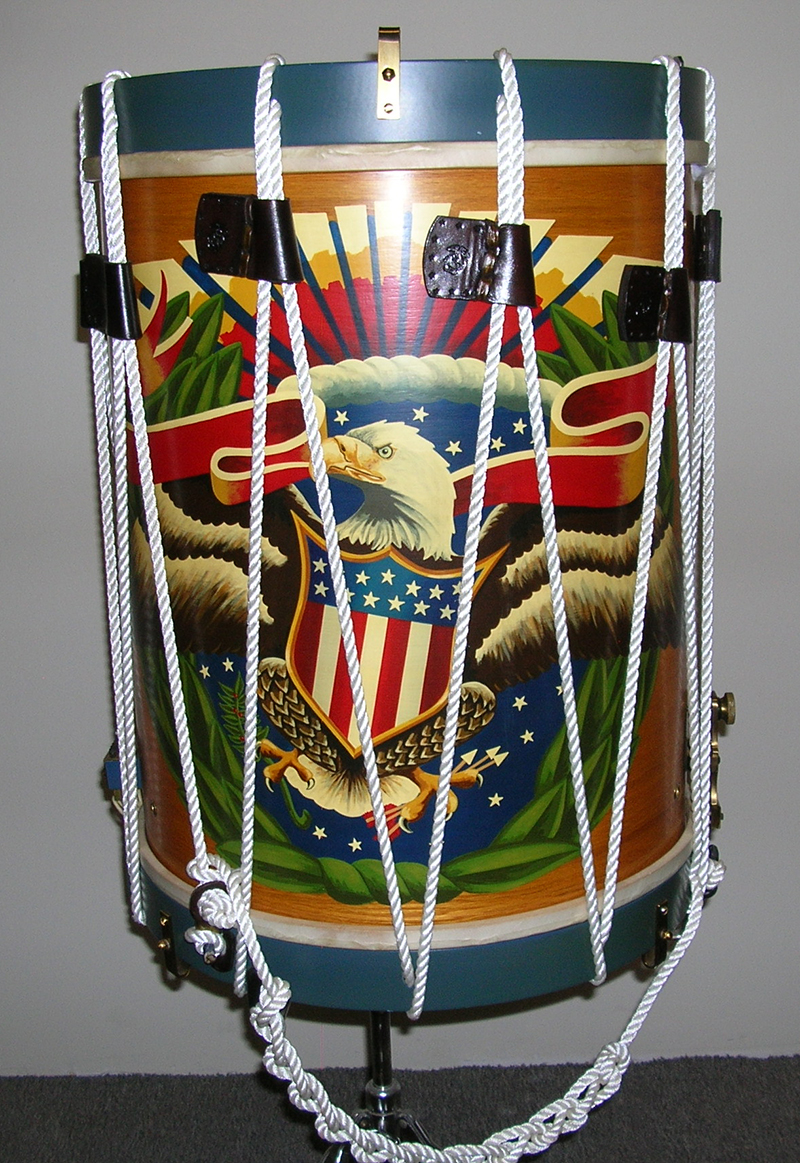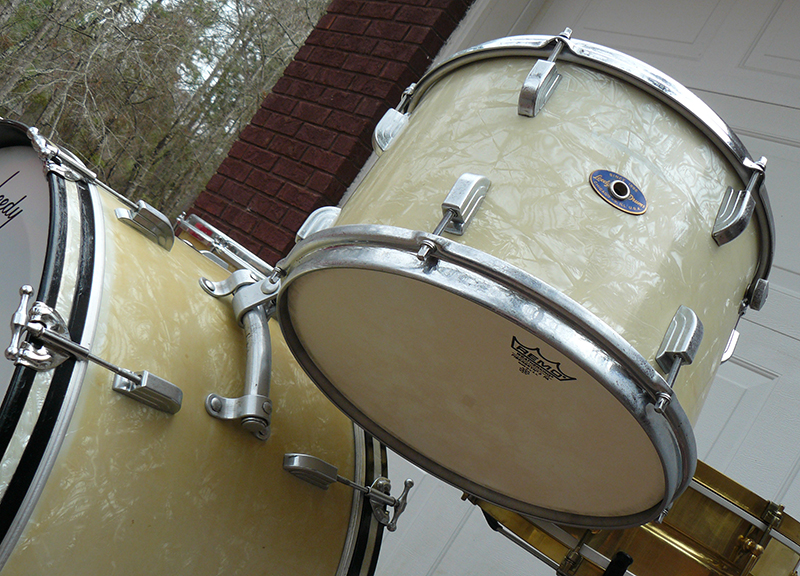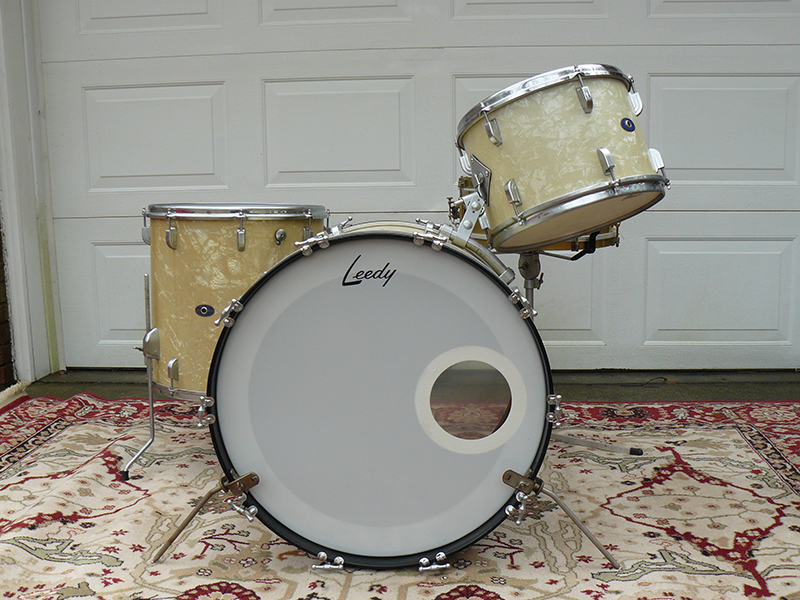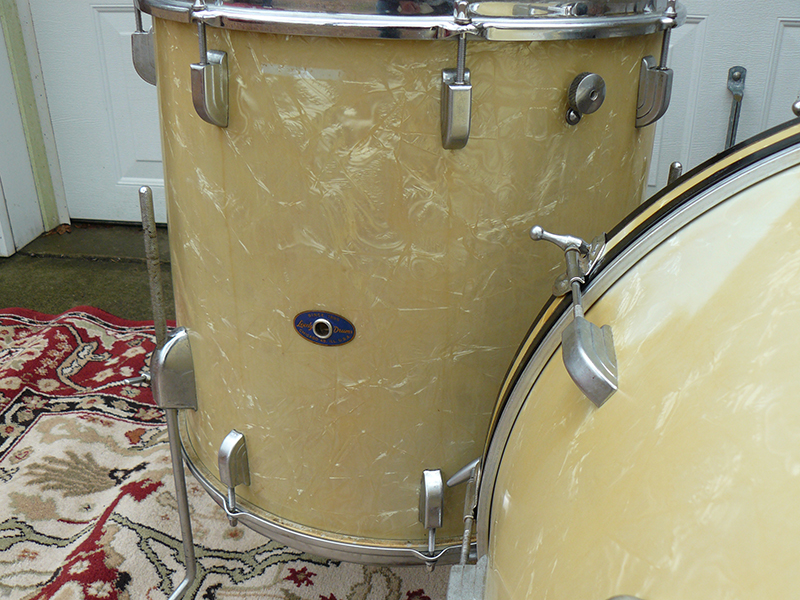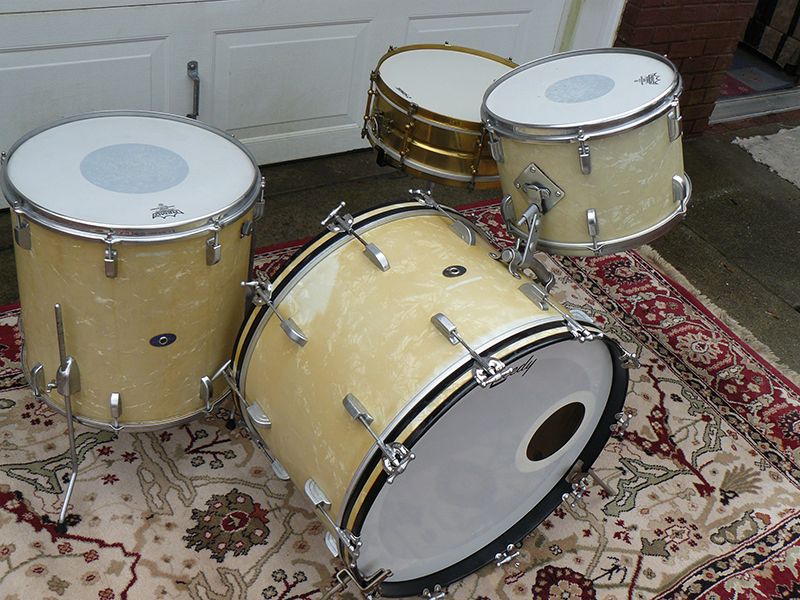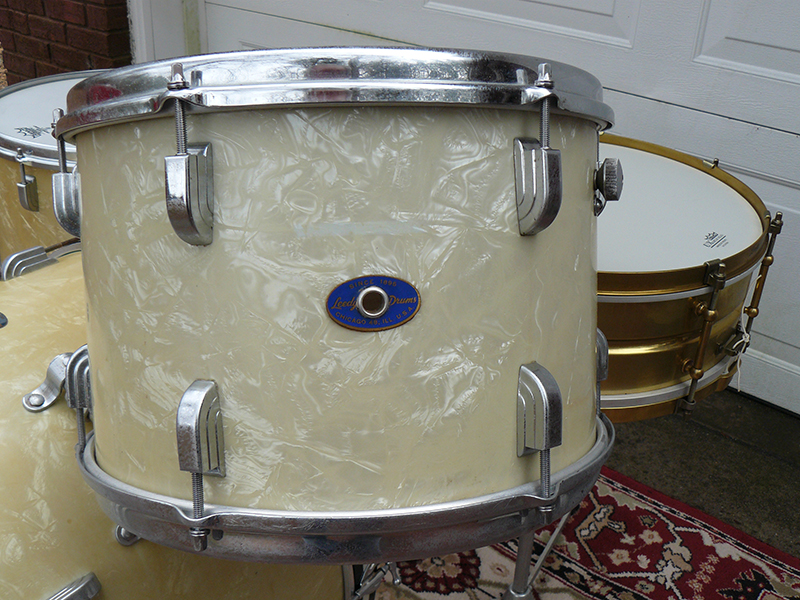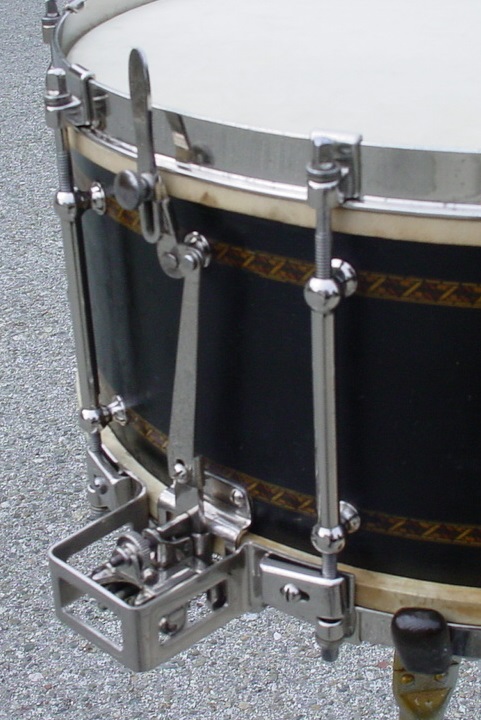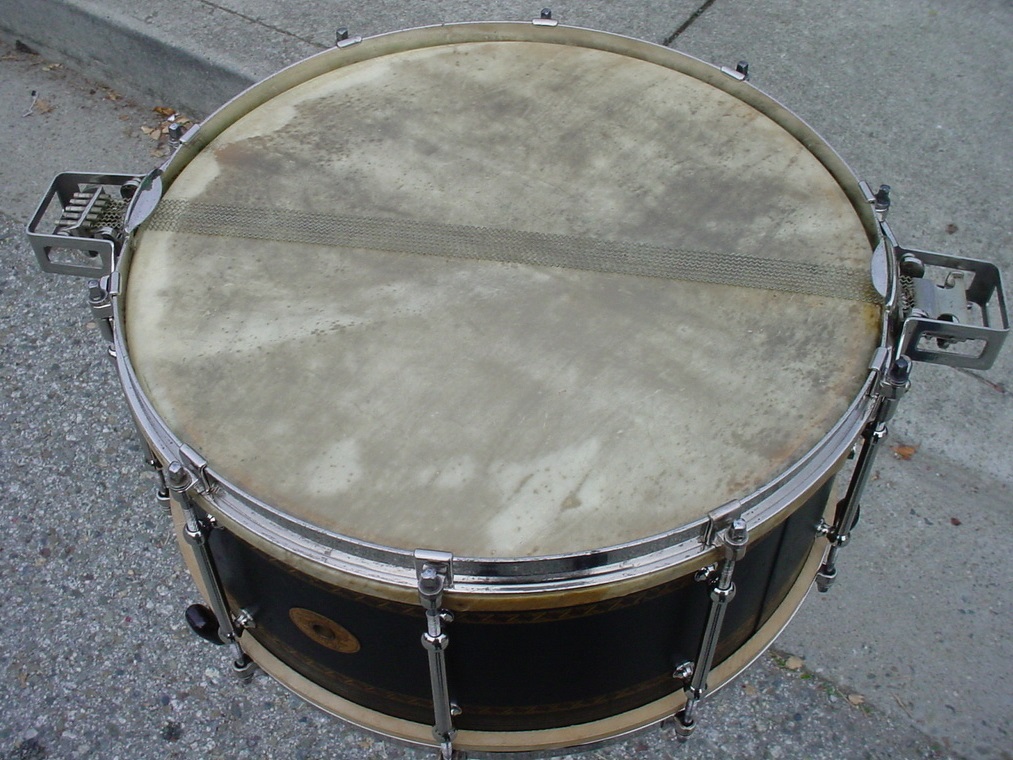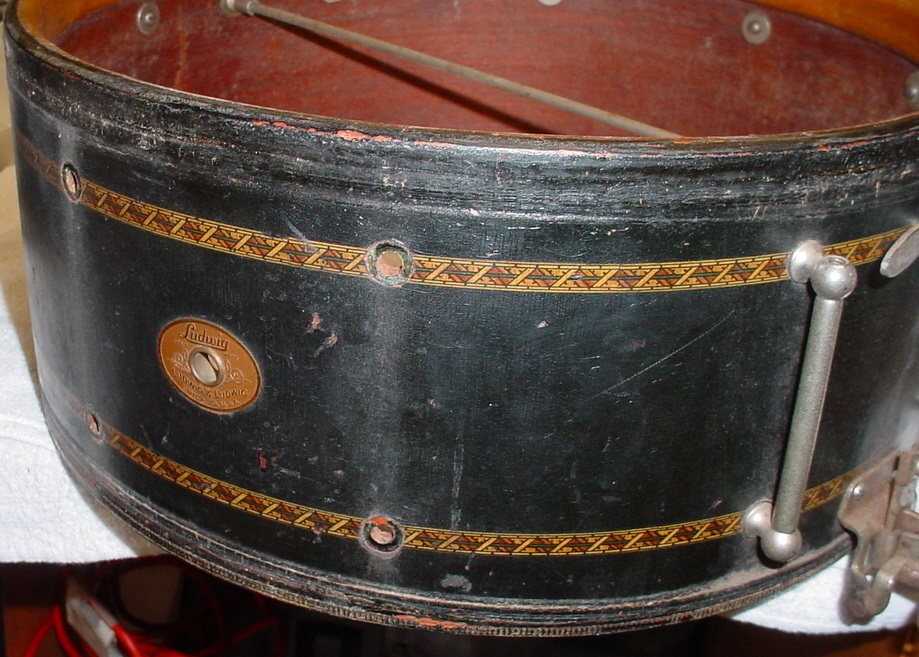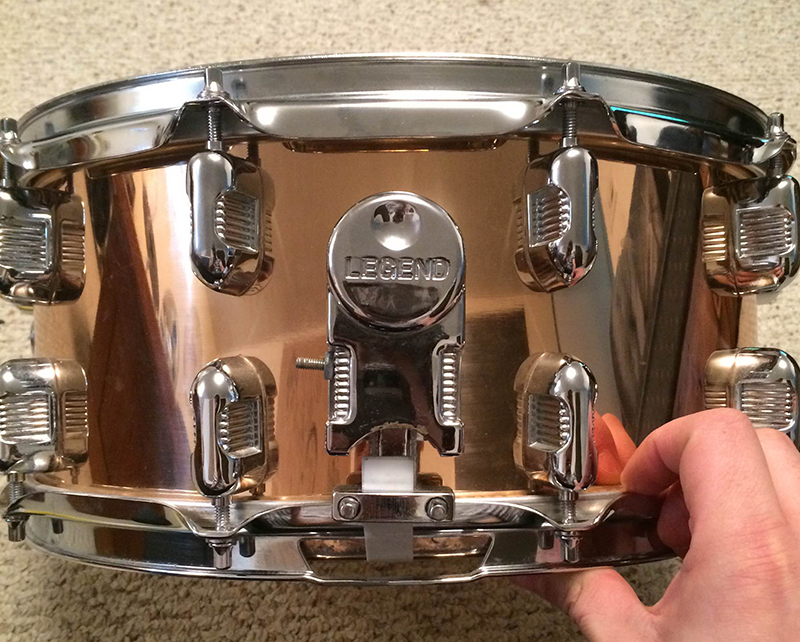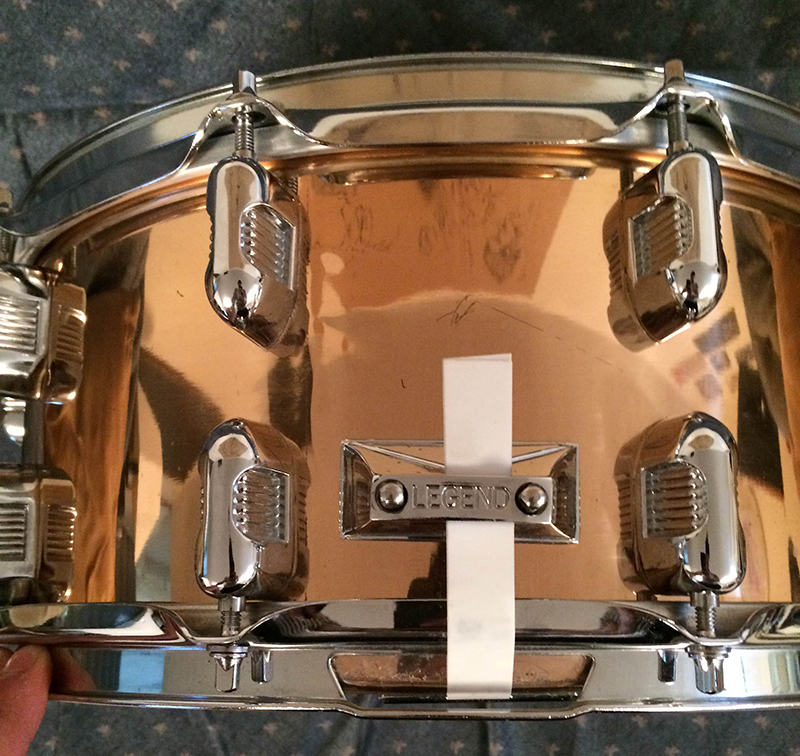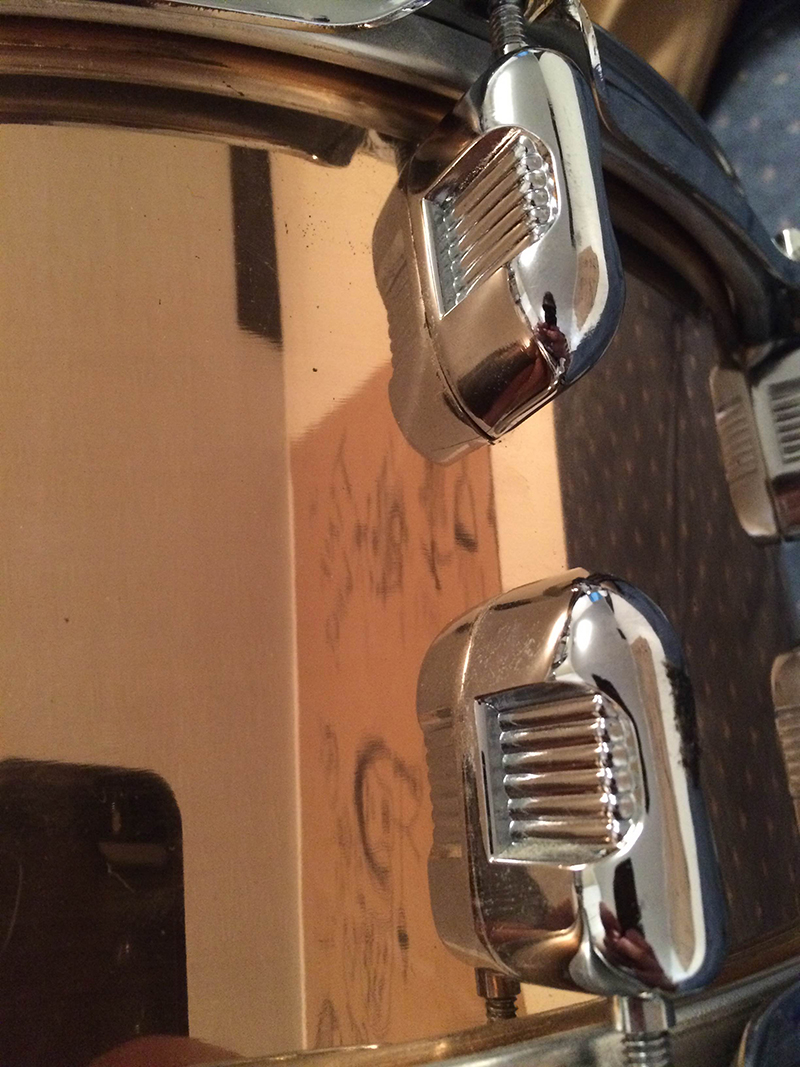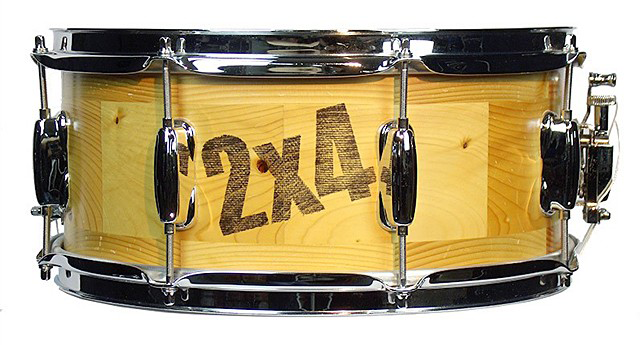This is one of those reviews that is easy to write because the product is so simple that it either works or it doesn't. It either does what the manufacturer says it does or it doesn't. This one works! CUSH pads are an alternative to the felts you use on your cymbal stand. They are made of a proprietary elastomer material, and are designed to allow the cymbals to ring longer and truer without muffling the sound or overtones. They don't collapse or take shape and always return to the original shape.
Read more1929 5x14 Ludwig & Ludwig Rose Pearl Standard-Sensitive Model
I love the Rose Pearl description by L&L: "Rose 'Pearl' is a red hot finish for red hot drummers. It has the zipp (sic), and the Pep, and is just what the collegiate chap has been looking for. Rose 'Pearl' looks best with DeLuxe rods....Prepare for that better job by getting a set of new Ludwig 'Pearl' drums.
Read moreWIW? George Way Casino Snare
"That one is in great shape. I estimate the value to be $600-$800" - Ronn Dunnett, owner of George Way Drums
Vintage Drums, Legendary Sounds
Between 1967 and 1972, Premier experimented with lots of different fittings and mounts on their drum sets; as discussed previously, many kits in circulation today don’t match catalogue sets as they are made up from shells and fittings from different models. One can usually determine the era of a set, but generally drums from this period are a mixture of shells and fittings so don’t fit specific catalogue configurations.
By 1976 Premier had settled on some hardware design choices, which became uniform across all models and these features remained through to the late 1980’s. The 1976/77 catalogue still gives us drum set model numbers - B202, 604,605, 606, etc and the B203 and B204 featuring internal liners (Resonator). However, we see the introduction of the 392-50 tom post mount and 392 double tom holder across all models, with matching bass drum and floor leg mount blocks. It’s noticeable that the sets in this catalogue mostly have 8 lugs on bass drum, but the larger sets such as the 305 and 717 feature 10 lugs on the bass, a feature that became synonymous with their flagship sets (Elite, Resonator, Soundwave).
1978/9 catalogue features three new kits – ‘Elite’, ‘Resonator’, ‘Soundwave’. Firstly I’m going to focus on the ‘Elite’.
Premier Elite drums, from late 1970’s
The Elite retains the individual model names from the previous catalogue, but all bass drums now feature 10 lugs except the 201 which is a 20,12,14 configuration. This is a set seldom seen and highly sought after. The bass drum featured fold out bass drum spurs with spikes & removable rubber tips. By now all shells were birch with beech reinforcement hoops, all toms came with ‘tone control’ dampers and all fittings were standard as mentioned previously.
‘Identified by their superb good looks and sound, and by the flush-braced tension brackets on double-headed mounted tom toms and bass drums, with matching styled brackets on snare drums and floor toms. This range gives you an incredibly wide choice of drum sizes, types and finishes.’
At a time when many companies still featured single lugs top and bottom on drum shells, Premier retained their ‘flush braced’ single lugs claiming that ‘they take most of the strain out of the opposing tension rods…so as well as looking good this takes the strain away from the shell allowing it to respond more naturally to your playing.’
Die cast hoops were standard on double headed sets, steel hoops on single headed concert toms. Single headed concert Toms were available from 6x6” up to 18x16” and double headed from 13x9” to 18x16”. Customers were encouraged to make up sets from a variety of options, which is why there are so many sets in existence that vary in configuration and colour. A lot of people get hung up on the fact that their kit wasn’t in the catalogue so isn’t original, but in truth the catalogues state that any size, combination and colour are available as custom orders with thousands of parts to choose from. All sets were fitted with Premier’s Blue heads and Lokfast hardware.
In the USA the set configurations that made up the Elite range had names such as ‘Baron’, ‘Kicker’, ‘Superstar’ and ‘Driver’ but like in the UK were available in custom configurations.
By 1980/81 production had moved to solid colours and we no longer see the pearls from the 1960’s and 1970’s. The typical configuration for the standard Elite set was 22,13,14,16 and although the 12x8 was still in production, double tom sets usually have a 13” and 14”.
The Elites were very popular kits in the 1970’s and early 1980’s played by many of Premier’s endorsers and remain popular among players and collectors today. Occasionally one appears in an unusual colour or with a stripe around the shell, probably a custom build. Most commonly they are in Polychromatic Gold, Red or black.
Premier Resonator, from mid 1970’s
Another of Premier’s flagship kits that originated in the 1970’s was the ‘Resonator’.
The Resonator was the brainchild of Alan Gilby who, in 1972, had experimented with metal liners in some of Kenny Clare’s Ludwig drum shells. The principles & design was developed with Premier, and so was born the Resonator; a drum set that had normal drum shells with a thinner 3 ply wooden ‘resonator’ liner sprung inside. The outer shell mounted all the hardware, leaving the resonant liner free to do its job as a smooth sound chamber, enhancing the drum’s projection.
The first Resonator was named the ‘Kenny Clare’ and appeared in the 1975 catalogue boasting ‘a new really professional outfit that represents the most dynamic breakthrough to hit the percussion world in years. It gives you the ultimate in sound, power and performance…’ Anyone who has seen these drums close up would immediately notice discrepancies between Alan Gilby’s original concept and Premiers production, namely by the fact that the bass drum spurs and tone control dampers fitted to the drums pierced the resonant liners!
It wasn’t until the late 1970’s with the fold out bass drum spurs and other fittings that had been standardized, that the Resonator’s internal liners were smooth and unhindered by any hardware (apart from the 392-50 tom post mount on the bass drum). Alongside the Elite, the Resonator was one of Premier’s flagship sets and remained so for a number of years.
It should be noted, that Gilby’s original design prescribed that the inner liners would act as the drums bearing edge with the heads resting on these rather than the outer shells. I have seen this feature on a couple of early sets from the mid 1970’s, but by the late 1970’s and early 1980’s the liners on all sets were flush with the bearing edges, which were standard Premier profile.
The resonator kits were essentially Elites with a resonant liner fitted – birch shells, with 3 ply beech sprung inside the shell - 10 Lugs on the bass drum and die cast hoops on the toms. The resonator had colour options available that other sets didn’t, mostly a choice of coloured band around the shells. As with all sets, sometimes a colour appears that has all the Premier drummers discussing in forums as to whether they’re original, but again it is to be noted that just because it isn’t in a catalogue doesn’t mean it doesn’t exist! Premier offered custom options on all their high end sets, so anything was possible.
They became popular among drummers on both sides of the Atlantic, due to the power and volume of the shells; most famously endorsed by Clem Burke who used them throughout his career in Blondie and right through to his work in the 80’s with Eurythmics.
In the early 1980’s Premier introduced the Black Shadow Resonator, which featured birch shells with the toms in power sizes, described as follows in the catalogue: ‘the finish is unique; a black glass like surface is achieved in a special process that takes no less than 8 days to complete. It captures the natural wood grain perfectly, wrapping it in a deep, dark shroud that subtly reflects and retracts ever changing hues of black with the shifting light.’ The first series of Black Shadow Resonators featured two sets of single lugs on the toms, but by the late 1980’s design had changed to flush braced lugs the length of the shell, in line with other Premier sets of the era. The Roklok tom post mount replaced the oval 392-50 mount and the tom post gave the option to mount a cymbal arm. Alternatively, one had the option of the Fastball tom post. Lacquer finishes were standard in white, red or black with matching lacquered liners. Premier introduced some bright colours in this era, offering yellow, blue and pink with matching liners! These are rarely seen, but really stand out from anything else on the market at the time.
While other companies were realising that clunky hardware attached to drum shells killed resonance, and so began to introduce Rims fittings to toms, Premier argued that their resonator shells had solved this issue a decade before. Premier ceased production of the Resonator in the early 1990’s but they remain a popular kit among players and collectors, in any of their models during their two decades of production.
Premier Soundwave, from late 1970’s
Premier’s other flagship kit that appeared in the late 1970’s was the Soundwave. This set differed from all other Premier drums at the time due to various new features. ‘Instantly recognisable by the smartly designed separate tension brackets on each tom tom and bass drum’ boasted the 1978-9 catalogue ‘offering a free, more vibrant sound.’ The drums featured steel hoops rather than die cast, and the tension rods were square rather than slot headed, offering a much more modern image in keeping with their competitors. All shells were birch with beech reinforcement hoops, fitted with tone control dampers and the same hardware mounts as the Elite and Resonator. Like the Resonator and Elite, bass drums featured 10 lugs. They were generally marketed as a double headed tom set, although concert toms were available, and factory fitted with clear, black dot heads.
The catalogue stated that the drums were ‘available in any finish’, and that despite the lug design differing, the drums could be mixed with those from the Elite range. Rick Buckler from The Jam had a white set that was custom built by Premier, containing a mixture of Soundwave and Elite shells in power sizes. By the early 1980’s, the hardware that came with these sets changed from the ‘Lokfast’ to ‘Trilok’ – heavy duty tripod stands, a move away from the flush based models from the 1960’s and 1970’s.
Sometime around 1982 the Soundwave Mk II was introduced with a slightly reduced shell diameter, allowing the head to overhang the shell improving sound (and maximising bearing edge/head contact). The design of the drums remaining the same as it’s first incarnation, but the lugs were fitted with plinths to raise them from the shells. (These undersized shells are not to be confused with the pre international drums of the 1960’s, the Soundwave sets took standard size heads). Bass drums were listed as being available from 20” to 26”, and double headed toms from 12” to 18”. Again, concert toms were available. Four new finishes became available in natural or stained wood ‘to show off Premier’s fine birch shells.’ These undersized shells were an exclusive for Premier, a design that was taken on board by other major drum companies in later years. The shells really sing on the couple of sets that I’ve come across, with lovely projection.
By 1985 the Soundwave was no longer in production.
Adrian Kirchler Bob Meyer Model 7x14
George, A few years ago I was at [Steve] Maxwell's in NYC and tried AK's [Adrian Kirchler's] Damian Reed model with the same snare arrangement. Steve let me take it home for a week and I dug it except for 2 things. It was too dry for my taste and you couldn't separately adjust the inner parallel wires and the outer splayed wires for tension. Adrian designed his take on an old Dresdner throw off, changed the shell from copper to brass and plated it all with 24k gold for more warmth... voila! The Bob Meyer Model 7 x 14 - 2 piece shell (like a 20's BB) snare drum.
I often use wood shelled drums (8" 30s Radio kings, Leedy B'way Parallels, etc) but when I want a powerful drum with great dynamic range and sensitivity, this is it!
Best, Bob Meyer
1970s Ludwig Stainless Steel Hollywood Set
It's beginning to get warmer and there will be more yard sales, and sometimes drums appear out in people's front yards. I always brake for a yard sale to make sure there's not a sweet vintage drum for ten dollars in amongst all the junk. Check out the local pawn shops from time to time also. Tell the owner you would like a notification if any drums hit the floor. I have found some great snares and sets in pawn shops. Get your friends to be on the lookout for drums as they travel. I get a photo of a drum on my phone from friends quite often. Most of the drums they find are the newer variety, but I always tell them thanks for looking out for me. My friend Bill Pace puts an ad in the classified section in local towns. He says, "Old Drummer looking for Old Drums." It works for him, and he gets calls about drums families have in the attic. eBay and Craigslist aren't the only source of great vintage drums. Get out there and look for them, because if you don't, that brass Supraphonic will remain in that closet for many more years.
I have a real great set from my collection to show you this month. It’s a 1970s Ludwig Stainless Steel Hollywood Set. Ludwig introduced its line of stainless steel drums in the mid 1970s. These drums look so great and have a loud and powerful sound. They are also quite heavy. We all know John Bonham played a big Ludwig Stainless Steel kit soon after they came out with Led Zeppelin. The downfall of these drums was the cost to produce them. The same could be said about the Vistalite drums also. By the early 1980s the stainless steel shell drums were discontinued. They have been reintroduced in recent years for a limited run. The cost of the new stainless drums is very high. There are quite a few of these original wonderful sets out there for collecting and also playing. These drums from my collection are standard sizes: bass drum 22"X14, floor tom 16"X16", mounted toms are 13"X9", and 12"X8". The snare drum on display with the set is a 70s 14"X6.5" Supraphonic.
I have a couple of Stainless steel drum set stories I thought I would tell you. My good friend Lige Moore bought a great stainless steel set and loaned them to another friend. Our mutual friend's home burned with the stainless set inside. The Supraphonic snare drum was saved, but the rest of the kit burned. The shells came through the fire, but they looked pretty bad. Lige had a second 22" bass drum that I still have. I have his bass drum and snare drum in my stuff. Lige also gave me the shells that were burned, so I buffed them and sold them on E-Bay. They had no shine but they were still pretty cool. Another stainless steel story - I was doing some work for a man and the topic of drums came up. He told me he played and had a drum set in his house. I told him I also played and would really like to see his drums. I figured he would have an import set, but boy was I surprised to walk in to his drum room and find a flawless Stainless Steel set with all original hardware and Zildjian cymbals. I just never expected that set to be there in his house. He had bought them new in 1977 and he had never played them outside of his house. They were dusty and needed heads and a good cleaning to make them look like they had just come out of the music store. I asked him If he would like to sell them, but he said he didn't. I asked him about trading him a new set of Pearl or Tama drums for them and he said he might do that, but as of yet he hasn't. I'm not telling any of you where they are. I'm hoping he will let me replace them one day. My set is nice, but his is much nicer.
Make a comment if you have or play a Stainless steel drum set. I would like to get your feedback.
March 2015 - Lots of News!
Heads up! Be on the look out for an email from DRUM! magazine and NSMD about winning a $50 Visa gift card for taking a survey about your playing and the drum gear you use. We'd appreciate it if you would take the time to fill out their survey.
Lots of news this month:
The Nashville Drum Show will not be produced by Not So Modern Drummer this year. Even though the show has grown every year and even made a small profit last year, from this point it would cost too much in time, energy and resources for my two man staff to handle growing it to the size it needs to be. Also, my personal pursuits in music will be taking up more of my time this year and I simply won’t have the time to do it properly. I am offering production of the drum show to any interested individual or company, with my assistance and resources. Please contact me if you are interested. The 2015 Snare Drum Olympics will still take place and information will be available shortly.
Chris Speich and Aaron Mlasko will be hosting the Not So Modern Drummer booth at the Chicago Drum Show in May. Aaron is the owner and builder of Mlasko Drums and will be displaying some of his immaculate drums at our booth. Please check out his ad in this newsletter and the Custom Drum of the Month.
NSMD’s gear and back issue sales are being switched to the Reverb Marketplace and the store name is being changed to George’s Drum Shop. https://reverb.com/shop/georges-drum-shop Reverb is rapidly surpassing Ebay as THE venue for music instrument and gear sales so we are going to set up shop there. Just to clarify, George’s Drum Shop is not a brick and mortar shop; no showroom, just online sales that are personally handled by me. I am still a staunch supporter of supporting your local drum shop. Fork’s Drum Shop here in Nashville is where I spend my money.
Many new products have been added to the shop and more are on the way. Recently added were Ronn Dunnett’s great throw offs and other parts. I will also be adding all the Snare Drum Olympics drums that are for sale. If you are interested in having your products represented and sold by George’s Drum Shop please contact me, george@notsomoderndrummer.com or george@georgesdrumshop.com.
As usual we have some great articles and columns from our regular writers. Please check them out and leave any comments that come to mind. And remember, “the drummer with the prettiest drums gets the gig!" :o)
Mlasko American Classic Drums 7x14 Vintage Mahogany
"Mlasko American Classic Drums are made in Nashville, Tennessee for drummers who can appreciate refined classic drum design without the limitations of vintage instruments. Owner, Aaron Mlasko has been building drums since 1994. He’s also worked as an in-demand touring and studio drum tech for folks like Matt Chamberlain, Matt Cameron, Alan White, Mario Calire and many others."
Read more
1953 Leedy & Ludwig Set
WIW? Ludwig Imperials?
Got something that you want to ask the community what’s it worth? Send it in and we’ll post it here. – NSMD NSMD,
I am very interested in purchasing a drum but I'm not certain who made it. I consider myself to have decent vintage knowledge but not after seeing this one. The shell has no name or stamp on it what so ever. Also very strange is that there is no center bead in the shell. It has no extra holes drilled in it. The lugs appear to be late 30's Ludwig Imperials. The strainer also looks to be Ludwig, later 20's to early 30's. There is a welded seam on the interior of the shell. Can you please help or give me an idea of what type of shell it might be.
Thanks, Lance
What do you think? Let us know in the comments below!
Stanley Krell’s Rogers Drums, A Once In A Lifetime Find
by Robert Bernhardt
Recently I acquired a set of Rogers Holiday drums from the Covington, OH era. I bought Stanley Krell's drums. He was a Rogers endorser in the early 60's. I think these drums were stored in their cases for the past few decades at least. The snare drum with this set is a very early/rare pre-oval badge Dynasonic. According to one of the resident experts at the Rogers Owners Forum, this is a once in a lifetime find.
I found these advertised on Craigslist. With the ad already posted for six days I didn't expect to even get an email back from the seller. Sure enough I got a phone call within thirty minutes of my emailing him. I arranged to go have a look at the drums that afternoon, knowing I needed to act quickly if I wanted to have a chance at buying these. Luckily, because of the Thanksgiving holiday weekend, I was the first person to see these. I'm new to the Rogers addiction, so I hadn't even seen a Holiday set in person. The second I saw these I knew these were different than the Fullerton script logo drums I just bought a month ago.
I bought these four cases full of vintage drums and drum equipment. The name on all the cases, as you can see, is Stan Krell. I got them from a wonderful guy named Joe, who buys estates. He got these with the rest of the contents of a home out on Long Island. The homeowner told Joe she bought these drums for her son, back in the sixties, from Stan Krell.
As you can see on the tag, the Dynasonic is serial number 3660. No oval badge, just the script logo. It seems to have the original reso head on the bottom. Needs a good cleaning but seemingly in very good shape for a fifty year old drum. The 12" tom seems to be the oldest, but I'll leave that for the experts. It's got a Cleveland sticker, serial 10880. The 13" tom has a Dayton sticker, with serial 88281. The 16" floor tom has a Cleveland sticker, serial number 42570. The 22" bass drum has a Dayton sticker, with serial 80690.
All drums seem to have the original Rogers heads still, with the exception of the snare. There is one beat up, 14" head in that rolling case though. Hard to tell if it's a Rogers now, but it's there nonetheless. I included a picture of a T-Rod and Claw as an example of the condition this entire set is in. I have a feeling these have been sitting in their cases since the sixties.
Camco bass drum pedal, Swivo HH stand, two 18" Zildjian Rides, 14" Zildjian hi hats, and what seems to be a Ludwig 10" splash cymbal. (Did they call them splashes back then?) The Rogers woodblock is interesting. Didn't do much research on it. I have to imagine that's rare. The cowbell seems very well made. No name on it, but it says Ludwig on it's hardware. A half dozen pairs of Regal Tip sticks from that time period. Some no name brushes, heavy and wiry. A Rogers drum key and a Ludwig drum key. The custom road cases themselves also just really add to the completeness of this find.
I'm going to play these drums. I'll probably re-skin them after an hour of light playing to preserve the heads, but I can't wait to get some time behind this set. I will never break any of this up either. That woodblock will not go up on eBay just because it's probably rare. I really think that Dynasonic should remain with the rest of this set too. Like I said in my original post, this is really like a time capsule. I definitely intend to keep it that way.
I welcome any info any of the experts would like to share regarding these drums. From what I can tell from the dating guide, the 12" was possibly made in 1957?!?!? The FT is early/mid sixties Cleveland while the 13" and the BD are mid/late sixties Dayton. That's all the research I've done so far.
My Drums - Their Story
I got to thinking the other day about my drums and their stories. Or is it about my stories attributed to the drums. Either way I believe that each drum, if it falls into the hands of a professional player, ends up with a story to tell. I am not a vintage drum collector but I have many drums and each has a tale to tell. Their story can range from how I got the drum, where it was used or the individual or company that made the drum.
I have already written about my 6 ½” X 15” single-tension Leedy Snare Drum - (March 2014). It opened the Eastman Theatre in 1922 with a fortissimo snare drum roll played by William G. Street for the Star Spangled Banner. The drum was then used by Oliver Zinsmeister in the “President’s Own” United States Marine Band and probably spent a few gigs at the White House. The drum is now here with me at the Eastman School of Music and has been used for many formal occasions involving the Eastman Theatre. Not a bad history for such a drum.
In another article for Not So Modern Drummer, I have written about the Rogers Drums that are part of the Eastman School of Music Percussion Department - (September 2014). I would like to single out one of the Rogers 6 ½” X 14” drums that is my personal snare drum. The Rogers Drum Company gave the drum to me since I was endorsing the drums and supplying the Eastman Percussion Department with their equipment. Now why is one drum so important? This drum was in my studio and played on by all the students for their lessons. It also had another function. It was the drum used for all the auditions at the school. I auditioned 1,618 students in my 49 years of teaching – only 258 of those who auditioned were accepted. This drum has seen the best and the worst. If it could talk, I am sure it would have stories to tell.
In 1976 the Eastman School of Music played host to the first Percussive Arts Society International Convention (PASIC). The Premier Drum Company was exhibiting at that convention and was featuring a rope tension drum 19 ½” X 17”. Jim Coffin was the man in charge of this exhibit and he being a friend of mind suggested that I buy one. I did and have had it ever since. I have played it on several occasions and each time I use it I am reminded of the convention and what a great event it was and the drums position in the history of drums. Inscribed on a plaque on the shell of the drum is the following:
REPLICA DRUM AS USED BY 71st (HIGHLAND) REGIMENT OF FOOT – FRASER’S HIGHLANDERS – 1776-1787 – LIMITED EDITION NO. 233- MADE IN ENGLAND BY THE PREMIER DRUM CO. LTD.
Having a son who is also a drummer/percussionist has its rewards upon reaching milestones in your life. When I turned 55 years old he had W.H. Reamer make me a replica of The Grand Army Republic (GAR) Drum with the emblazonment of the Eagle clutching arrows and a shield – 21” X 17”. Since I was also in the “President’s Own” United States Marine Band, W.H. Reamer emblazoned the shell with the Marine Corps Globe and Anchor, my name and dates I served in the band. This is a beautiful drum that sounds as good as it looks. I have used this drum on countless occasions for rudimental demonstrations, clinics, parades and lectures. Inside the drum across from the vent hole there is plaque that reads:
PRESENTED TO JOHN H. BECK BY JOHN R. BECK – FEBRUARY 1988
I also had W.H. Reamer make the same drum for my son. Now we have matching father and son drums. He was also in the “President’s Own” United States Marine Band and has the Eagle and the Globe and Anchor on the shell.
As I mentioned in the previous paragraph about having a son who gives great gifts at milestones in my life, the 6 ½” X 14” Orlich glass drum was a gift when I retired from playing timpani in the Rochester Philharmonic Orchestra after 43 years. As you can see the plaque reads – JOHN H. BECK – ROCHESTER PHLHARMONIC ORCHESTRA - 1959-2002. This drum was a big surprise to my students as well as some auditioning students. I always had my Rogers Drum for them to play on but had the glass drum there so they could experience its tone and feel that I might add is great.
There you have the story of MY DRUMS – THEIR STORY. You can decide if drums have a story or the player gives them their story – I think it is collaboration between the two or said in another way – IT IS A WIN WIN SITUATION.
1960s Leedy Shelly Manne Set
I really like Leedy drums. I know some of you share my passion for these fine American made drums. I just love the history of this company, and besides, the drums are high quality and beautiful. When I was a young boy there was a sign artist that lived next door to us. He painted signs for businesses and such, and he was a very good painter. On day I went over to his shop and there was a drum head he was painting for a local band. They were called The Wild Cherries. I remember the look of the letters on the head and what stuck out the most was the Leedy logo on the head. I had seen the Ludwig logo on Ringo's drum head and I was not as dumb as some people to think it was part of the band's name. I had never heard of Leedy drums and so I guess I was dumb at first to think the band's name was Leedy the Wild Cherries. I soon started learning information about Leedy drums from another drummer who told me they were the same as Ludwigs. That information wasn't exactly right even though Ludwig and Leedy were owned by the same company for many years, and Leedy and Ludwig were even combined for a few years in the early 1950s. Then I had a friend who had a set similar to the set I'm featuring from my collection this month. He told me Leedy was not just like Ludwigs they were just like Slingerland drums. He was also somewhat right, because Slingerland bought Leedy from Conn in the late 50s and basically made what some people call "Slingerleedys". This drum set from my collection is a Slingerland built Leedy set from the early 1960s.
Leedy drums from this era (1956-1965) are very similar in every way to Slingerland drums with the exception of the lugs and badges. This set is a 22", 16", 13" set in standard depths. The lugs are Beavertail Leedy Lugs. You will hear the expression "Art Decco Design" when referring to these sleek modern looking lugs. The blue oval Leedy badges have Chicago 48, ILL. USA on them. This will date them 1960's. The first Leedy badge Slingerland made was a brass oval that dates drums mid 50s. The first blue oval badge '57-'58 didn't have the 48 after Chicago. The rims are "Stick Savers just like Slingerland drums. The Finish is yellowed white marine pearl. The set looks almost butterscotch. The yellowing is not consistent over the whole set. Something interesting to notice in the photos are the unfaded areas on the kick drum. The set had a cloth muffler across the batter head with excess cloth covering an area on the shell. Where the cloth shaded the shell the finish is still white. There is another white area where the front calf head was not tensioned equally. The place where the head covered the shell is still gleaming white. There was also a small sticker on the bass drum shell by the badge, and on the floor tom shell that covered a small spot. If the drums had been kept covered by a sheet when not in use they would probably be a lot whiter than they are now after 55 years. Any way, I still love that vintage "vibe" these drums have. They are beautiful to me.
I always share my adventures in collecting, because it is a lot of fun and exciting to score a great drum set. I buy some drums on E-Bay and I am not at all knocking that method of acquiring vintage drums, although It is like fishing in a barrel. It's more fun, and you really feel like you have scored when you find drums at good prices from owners or unlikely places. I realize that's more difficult now and it's becoming more difficult all the time. These drums were owned by my great friend Butch Braddy. I've told you before that he has helped me get a lot of drums over the years. He is the sales manager of the drum department at a large music store in a local city. He gets the opportunity to pass on or buy a lot of great vintage drums. I am so glad he's my friend. If he is letting something go or thinning his collection, I get a call. I try to keep some cash ready for just such an emergency. He called me recently to tell me about this Leedy set that he was parting with. I was there to lift his burden as soon as I could get to him. Thanks, Butch for this great set. Until next time, always peek into those dumpsters. You never know when someone has tossed out a Leedy Black Elite snare drum.
1928 Super-Ludwig Nickel-Over-Brass
As many vintage collectors will agree, the early 1920’s – 1930’s Ludwig heavy brass snare drums had a certain ‘mojo’; a magical feel and sound that you just don’t hear in modern drums today. I’ve been seeking out these rare drums for many years. One day, I came across Facebook posting from a drummer in New Zealand showing a late 1920’s, perhaps early 1930’s, Super-Ludwig 5 X 14”, 10-lug, nickel-over-brass snare drum in very good condition. I sent him a message inquiring about the drum. I was a little cautious at first, as he wasn’t using his given name on Facebook, and New Zealand was a long way to ship a vintage drum. We exchanged a few emails followed by an interesting long-distance call to the land of the Kiwi’s. The owner was a Scottish drummer now retired and living in NZ, now known by his stage name, Will McCee. The Super-Ludwig had been passed down to him by his brother, who inherited it from their father. Their father bought the drum around 1928. He described finding the drum in a shed, “He (Dad) was real fussy & when I unpacked this drum, it was covered in grease. It looked like a real mess, but after it was cleaned, we could not believe what we were seeing - even the snare throw-off looked like it just came out of the box. It has not been re-plated so it beats me what to say. I haven't even polished it, just soft clothed it… It looks like he played it with the snare guards off for some reason. They were packed in a box with the screws inside the case and were like new. I have no idea why, but that's the old man… I only wish I knew more about its history, but I do know he favored this drum over all others. When he got a new kit, he always ordered it without a snare drum and kept this drum.” So after some back and forth, we came to terms; he even threw in his Dad’s drumsticks, case and the (tattered) canvas bag in which he found the drum.
I waited patiently for the drum to arrive, but in the meantime, I did some catching up with a few vintage drum catalogs. In the 1928 Ludwig catalog, the Super-Ludwig No. 231 5 X 14” ‘All-around model’ was described as “the sensation of the drum world” and sold for a mere $45. Ludwig went to great lengths to describe the many attributes of this exquisite snare drum: “Perfect snare action control is the secret. The Super-Ludwig is so designed that snares are adjusted individually. Each snare can be tensioned separately. The snare throw-off is made in a parallel line. That means that the snares go off and on under tension. Once you make your snare adjustment, you can depend on it to remain exactly as you have set it. The snare action is absolutely certain. Playing is easier and you can get snap and instant response of all the snares from any point from rim to rim. The snares have a longer play and consequently are more free to vibrate. You can use either gut or wire snares and change in less than a minute. It has every good feature you ever desired in a drum. The Super-Ludwig fills the bill for the drummer who wants the best and will have nothing short of that. The Super-Ludwig Snare Control is positive. It is quick to act and there is only one main adjustment. (No more than the ordinary strainer.) This drum sold with gut snares, silk-wire covered or coiled wire optional. Wm. F. Ludwig, selected, batter head and Ludwig Crown Brand snare head.” That certainly would have sold me.
So to my relief, the drum arrived a short while later, with no shipping damage (never assumed given the distance). It had some minor pitting but was in overall excellent condition for being almost 90 years old. As described, the drum had a two-piece nickel-over-brass shell with the edges folded back to the inside of the shell (like the early Black Beauties), ten tube lugs, and a fully functional Super-Ludwig snare mechanism. “Ludwig” and in smaller block print, “Trademark”, were engraved into one of the upper panels. “Super-Ludwig” was hand-engraved into the bottom hoop (not stamped like later models). Included were Will’s Dad’s drumsticks, case and the tattered canvas bag that had protected it for some many years. I put modern heads on the drum, as the intention was not to let it sit idle on a shelf. I truly love the pop of the straight, single-flanged hoops and the deep, punchy sound one can get out of these heavy brass beauties. The Super-sensitive strainer may not be for everyone but I do think parallel action strainers give a more uniform, sensitive response. However, they have a tendency to disengage when played loudly.
I assured Will that I would take good care of his father’s drum, preserving it for the next generation. He seemed quite satisfied by this promise. I don’t think it was easy for him to sell. Will wrote later, “I am so pleased you like it. I'm glad you are not here to see the tears in my eyes - enjoy it as much as Dad did. Thank you for finding it when you did. I needed something to take my mind off my problems and I was worried that my gear would end up at some auction with people bidding who had no idea about drums - so it is a win, win situation.” This Super-Ludwig now sits in honored company with other heavy nickel-over-brass shell contemporaries, a Ludwig Super-Sensitive and a New Era (all 5 X 14”). But that’s another story… Now, I just need to find the 6.5” counterparts… :o).
1925-32 Ludwig & Ludwig 6.5x15 Black Ebonized Inlay Super-Ludwig Band Model
By Mike Curotto
Hi all,
This snare drum was a gift to me from my good friend and fellow drum collector Bun E. Carlos. We had done a couple of big deals at the 2012 and 2013 Chicago Vintage Drum Shows so as a thank you Bun gifted me this drum.
1925-32 LUDWIG & LUDWIG 6.5 x 15 BLACK EBONIZED/INLAY SUPER-LUDWIG BAND MODEL
The Shell:
The Black Ebonized finish (1925-1939) was originally a special order but in later catalogs it was offered at no extra cost. The finish shows its age but is all there and cleaned up nicely with a product called Naphtha. I just learned about this product from a friend who does a lot of custom woodworking. I am happy with the outcome as this product did not harm the finish. The Black Ebonized finish is also high-lighted with two “decorative” faux inlay decals that surround the shell. The solid mahogany shell interior is in good shape and is factory-marked ”BLACK”. The brass oval badge is clean with a tight grommet. There is no tone control, definitely pre-1933.
The Hardware:
The nickel hardware is all original but it definitely needed a good cleaning and polishing. Everything came out great. The Super mechanism works perfectly. The bottom rim has the stamped “Super Ludwig” which puts it after the earlier engraved “Super-Ludwig” models. The original Super wires are intact and work well.
Of-the-era top and bottom calf heads rounded out this restoration. These 6.5 x 15 Super-Ludwig Band Models are classic examples of a great era. Thanks again goes to Bun E. Carlos for gifting me a great drum.
Enjoy!
WIW? Legend Copper Snare
Got something that you want to ask the community what’s it worth? Send it in and we’ll post it here. – NSMD Anthony Foti wants to know opinions on what this Legend copper snare is worth.
What do you think? Let us know in the comments below!
February 2015 - Brrrr!!
Ah, cold, cold, cold, February! You make us want to stay inside and obsess over our vintage drums! Not much to report from the Eastern front but these few tidbits-
Read more2x4 Famous Snare Drum
Famous Drums' "2x4" Custom Snare Drum
Put the Drums in the Organ, Please...
1932-34 Slingerland 5x14 Artist DuAll Model (“Pulley” Version)
By Mike Curotto
Hi All,
A few years ago I was contacted by drummer/educator Ed Soph who wanted some information about this drum. I told him what I knew and after a few months I was able to purchase the drum from Ed. Over the years I have discovered three versions of the Slingerland DuAll mechanism: 1. A center post very similar to if not a direct copy of the Super-Ludwig center post (usually equipped with a Tone Flange). 2. An interior “pulley” type mechanism instead of a center post (no Tone Flange). 3. No center post and no “pulley” mechanism (no Tone Flange). This snare drum has the “pulley” mechanism
The Shell: Green Sparkle from the 1930s is notorious for having black “cancer” spots. Fortunately this drum is cancer free. The finish had the normal years of accumulated schmutz but everything cleaned up and polished up nicely. The interior of the solid maple shell was very clean with no re-ring separation other than a 2” section, no big deal. The shell has normal bearing edges top (no Tone Flange) and bottom . The cloud badge is very clean with a tight grommet. Lastly, a nice factory pre-assembly artifact was found on the interior of the shell...”Nickle DuAll”.
The Hardware: The nickel hardware was in great shape and was very easy to clean and polish. There were a few errant tension rods but I had the era-correct replacements in my parts stash.
The internal DuAll “pulley” mechanism is clean, well built and looks kind of artsy. The mechanism is smooth, works well but is not as solid as the center pole version that brought on the patent lawsuit by Ludwig & Ludwig. I’ve included interior and exterior photos of this version of the DuAll mechanism. The reader will clearly see the similarities to the already patented L & L Super-Ludwig mechanism of the same era. The manufacturer’s cartouche markings on the snare gates are “L” and “LL”.
The Slingerland Artist DuAll Model was only in production for approximately two years and due to this very limited production run Slingerland DuAlls are extremely rare. As far as my snare drum collection goes, my un-scientific guesstimate based on the number of Slingerland DuAlls I own vs. the number of L & L Super-Ludwigs I own is about 15:1 meaning for every DuAll I own there are 15 Super-Ludwigs that I own. If we look at the more realistic bigger picture out there in the collecting world my guestimate is more like 100:1. That’s just my very un-scientific observation. As always, feel free to weigh-in on the subject as I look forward to your comments and added information.
A nice Frank’s Drum Shop calf batter head, Slingerland slunk head and the original snares rounded out this cleaning/restoration.
Enjoy! Mike Curotto


